Are you looking to add some life to your small aquarium? Wondering how to choose the perfect inhabitants for your cozy aquatic space? Look no further! In this comprehensive guide, we’ll explore the world of nano species. Discover the joys of creating a miniature underwater paradise.

You have a small or medium-sized aquarium in your office or at home and wonder how to make it more lively.
This is easy: I have a couple of options on my mind and while these are nano species of schooling fish that are beautiful to observe they also fit the bill perfectly.
But what are the best freshwater inhabitants for a tiny 3.5 to 5-gallon tank?
This is not a lot of swimming space so I tried to list species that generally remain under 1 inch in length.
I finally decided to write about this because for some time now many of the new fish-keepers that read my blog have been asking me about the right micro pet fish for a freshwater aquarium.
Today I want to respond to these and a couple of similar queries or concerns you may have.
For instance, are there cold-water alternatives to the tropical species that suit a compact aquarium?
What are the types of small fish that remain the same size in their full-grown state?
I’ve compiled a list of the smallest freshwater nano fish that can live in a tiny tank based on my personal experience and some research I did.
Quick Sidenote: Do you want to watch this article instead of reading it? Checkout the highlight video below from our YouTube Channel (Or read the more detailed article below), be sure to Subscribe For More Great Fishkeeping Content:
Let’s dig in.
Right before we start, I will share a photo of one of my all-time favorite fish for small aquariums, the Celestial Pearl Danio (or also known as Galaxy Rasbora):

20 Tiniest Freshwater Aquarium Micro Fish
I took considerable time off to do some deep research on nano fish that would best suit a freshwater aquarium.
I combined that with my personal experience in fish keeping and I made sure to not list fish that get over 2.5 inches in full-grown length.
Here are the 20 smallest freshwater aquarium fish that are perfect for a nano tank:
1. Indonesian Superdwarf fish – Paedocypris Progenetica
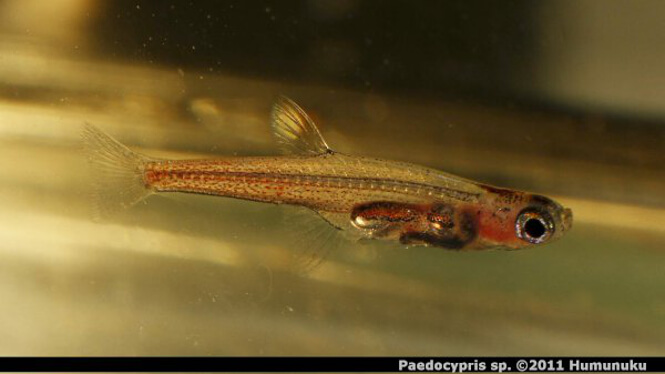
| Maximum Size: | 0.41 inches (1.04 cm) |
| Suggested Tank Size: | 3 gallons for a small group |
| Suggested Water Temperature: | 75 to 82°F |
| Suggested pH range: | 4 to 6.5 |
The Indonesian Superdwarf fish from the Paedocypris genus is a titleholder of sorts. Native to the peat swamp forest of Indonesia, specifically in areas like Sumatra and Borneo. This tiny aquarium fish is critically endangered because of the continuous habitat destruction.
It was the smallest known vertebrate until the tiniest frog (Paedophryne amanuensis, discovered in the rain forests of New Guinea) leaped past in 2012.
An adult female Paedocypris Progenetica grows to a maximum of 0.41 inches (1.04 cm) only, while the mature males are a mere 0.39 inches (0.99 cm). This makes it one of the smallest fish species known.
Regarding life expectancy, Indonesian Superdwarf fish often have a shorter lifespan in comparison to larger freshwater fish breeds when it comes to life expectancy compared to larger fish species. In captivity, under optimal conditions, they can survive for approximately 1 to 2 years.
To put things into perspective, an average adult specimen is the size of an adult mosquito! Seven Indonesian Super dwarf fish can thus comfortably shoal in a 3-gallon tank.
That being said, Paedocypris Progenetica still holds a world-record title: it is currently the smallest freshwater fish in the world that can live in home aquariums.
In fact, it still remains the smallest nano fish species in the world overall discovered to date.
Paedocypris Progenetica has a thin and somewhat transparent body with rather weird pelvic fins that have clutching pads that males use to grab the females during mating. This unique feature makes it a fascinating subject for those interested in unique freshwater fish.
It is considered the cousin of the Paedomorphic Cyprinid fish family because they share similar features like an unprotected brain (their narrow frontals are the reason for this).
If you get your hands on Paedocypris Progenetica know that it’s a freshwater fish that likes its aquarium water acidic.
These waters are generally more acidic than rainwater; they have a pH 3 acidity mainly due to the decomposing tree leaves inside that also give the swamps the dark tea color.
Aquarists have found that imitating the natural habitat of these fish, particularly the acidic, nutrient-poor waters of peat swamp forests, is essential for their well-being and breeding behavior. This may involve using specialized substrates, such as peat moss or leaf litter, to mimic the fish’s native environment.
Therefore, the Indonesian Superdwarf fish are a perfect addition to a 3 to 5-gallon blackwater planted tank for those looking to create a nano aquarium aquascape.
The Paedocypris Progenetica is an expert-level fish to keep. All of this on top of how rare this fish is. I would not really recommend this species to beginners.
This species is now facing an extinction threat due to habitat destruction in its ecosystem in the wild. Conservation Paedocypris Progeneticais hindered by its limited range and the continual degradation of its habitab caused by human activities.
Establish protected areas and implement sustainable land management practices to safeguard the remaining habitats of this remarkable species.
Suggested aquarium gear for a school of 15 Indonesian Superdwarf fish:
- Tank: Fluval Spec V 5-gallon aquarium kit (20.5 inches of horizontal length, comes with LED lights that can support beginner aquarium plants, and has a filter)
- Heater for tropical water conditions: This small and strong heater will do
- Indian Almond Leaves: they will darken the water and lower the PH
- Driftwood will also be beneficial to this aquarium setup as it lowers the water’s PH even more, over time
Substrate: I can recommend this Aquasoil which will help with growing lush aquarium plants and will also significantly lower the PH in the water (you can also check more aquarium soil options here)
2. Pygmy Hatchetfish – Carnegiella myersi

| Maximum Size: | 1 inch (2.54 cm) but they’ll generally remain around 0.8 inches (2 cm) |
| Suggested Tank Size: | 10 gallons |
| Suggested Water Temperature: | 74.3 to 79.7°F (23.5 to 26.5°C) |
| Suggested pH range: | 4.8 to 6.4 |
Coming from the Carnegiella genus, the Pygmy Hatchetfish are gracious and timid schooling micro fish. They are so peaceful that they can easily co-exist with other animals in a fish tank as long as the tank mates do not harass the Hatchetfish.
The Pygmy Hatchetfish is a unique freshwater fish known for its gentle nature and ability to thrive in community tanks
When it comes to tank mates, Pygmy Hatchetfish are compatible with several small, peaceful species that inhabit similar water conditions. This fish definitely needs equally timid aquarium companions, such as Loricariid catfish and small tetras, rasboras, and dwarf corydoras.
These tropical fish for fish tanks are best kept with other fish in a small tank to ensure a harmonious environment.
The Pygmy Hatchetfish is silvery in appearance and originates from the Amazon River basin in Peru. This beautiful freshwater fish is one of the more striking types of freshwater aquarium fish, adding a unique aesthetic to any aquarium.
The Pygmy Hatchetfish are among the best community freshwater aquarium fish that stay small throughout their lifespan. They grow to a maximum of 1 inch thus remain small at their maximum size and length making them perfect for a nano aquascape.
They love swimming around the top of the aquarium, which makes them surface dwellers.
Therefore, you should ensure there’s a lid over the aquarium because your Pygmy Hatchetfish might try to jump out.
A 10-gallon aquarium is okay for these guys because they won’t take full advantage of its depth.
This implies that more water surface area is needed for their habitat, even though they don’t grow large in body size.
Pygmy Hatchetfish are known for their calm nature and shoaling behavior, often forming tight-knit groups in the aquarium. Observations indicate that these fish show strong shoaling tendencies, forming cohesive groups within the aquarium.
Research has demonstrated that Pygmy Hatchetfish prefer to remain in close proximity to conspecifics, showcasing coordinated movements and synchronized behaviors within the shoal.
They need to be kept in a school of at least 6 companions to fully enjoy shoaling.
Adding floating plants such as Mosquito Fern or Red Root Floaters is also an excellent option for the Pygmy Hatchetfish. Also, ensure the water is still so the fish can enjoy moments of calm.
In my observation, high water current tends to stress Pygmy Hatchetfish.
They also prefer dim lights, which can be easily achieved if you follow my advice of adding a chunk of floating freshwater plants in the aquarium. Advancements in aquarium lighting technology have facilitated the growth of floating plants such as Amazon frogbit and water lettuce, which provide shade and shelter for Pygmy Hatchetfish while increasing surface area. Visit the link to skim my article on good options for that.
Innovative approaches to providing adequate surface area and water flow for Pygmy Hatchetfish habitats have seen significant advancements in recent years.
Aquarists nowadays are using biofilm reactors more often as an effective method to enhance water flow and surface area within Pygmy Hatchetfish habitats. These reactors utilize beneficial bacteria to break down organic waste and excess nutrients.
Another innovative approach involves the use of surface skimmers specifically created for nano aquariums. These compact devices efficiently eliminate surface debris and protein film while promoting water circulation and oxygen exchange.
Pygmy Hatchetfish is an insectivore, it eats small insects on the water surface.
You can alternatively prepare bloodworms or small dried insects for them.
Feed them once or twice a day.
The ideal water temperature for this freshwater nano fish is 23°C while the Ph should be at 5 and 6.
Suggested aquarium gear for a school of 6 Pygmy Hatchetfish:
- Lights: If you go ahead and add floating plants, then check these aquarium lights. These grow lights are perfect for aquariums with floating plants and some low-demand plants on the bottom of the tank.
- Filtration: For a small tank with 6 Pygmy Hatchetfish I recommend using this Sponge Filter because it is super quiet and yet – efficient. Supply it with a small air pump and connect the two with airline tubing: Check the Air pump here and also this Airline tubing
- Heater: If you have a 10-gallon tank with a school of Pygmy Hatchetfish, then this heater
will do a fantastic job at keeping the preset temperature, without exceeding it.
PH Regulation: This nano fish species require low PH in its water, so if you are looking for an easy and natural way to achieve this, add some Almond leaves to the aquarium.
Want the most colorful freshwater fish for your aquarium? See more in this article featuring exotic species.
3. Stiphodon Goby – Stiphodon sp.

| Maximum Size: | around 1.5 inches (3.8 cm) |
| Suggested Tank Size: | 10 gallons or more |
| Suggested Water Temperature: | 68 to 77°F (20 to 25°C) |
| Suggested pH range: | 6 to 7.5 |
Neon Stiphodon Gobies, scientifically known as Stiphodon atropurpureus, are gaining popularity among aquarists for their vibrant colors and unique behaviors. The Neon Stiphodon Goby is a small freshwater fish that reaches no more than 1.5 inches or 3.8 centimeters upon maturity.
These species are among the members of the Stiphodon genus.
I do not recommend looking after these fish if you’re still a beginner in the hobby.
First of all the colorful Neon Stiphodon Goby Neon also known as blue neon Stiphodon gobies is a herbivorous species of nano fish that should graze on algae and biofilm.It is essential to provide a diverse diet with algae-based foods like spirulina flakes , algae wafers to suit their nutritional needs.
Offering any sort of meat to these fish may actually harm their digestive system.
To maintain a healthy diet for your Neon Stiphodon Goby you could simply get a product called Bacter AE, which will supply the aquarium with biofilm. Bacter AE introduces various sets of bacteria that produce large enough amounts of biofilm in the system.
Advanced techniques for sustaining algae growth and biofilm development in aquariums Blue Neon Stiphodon Goby have become increasingly refined.
Aquarists utilize algae reactors or refugiums equipped with high-quality lighting and nutrient dosing in order to stimulate the growth of various algae species favored by Stiphodon Gobies. These systems provide a dedicated space for algae cultivation, allowing for controlled growth and harvesting.
Another technique is the implementation of live rock or porous ceramic media that is specifically designed to promote the growth of biofilm. These substrates serve as an ideal surface for beneficial microorganism and algae to colonize.
You could also ramp up the lighting period of your aquarium lights to between 9 and 10 hours a day.
This encourages algae growth, which is another main source of food for the small Neon Stiphodon Goby. Having grow lights that are designed to support the growth of aquarium plants helps in this situation.
Do note that Black Algae will be the least appetizing type of algae for your Neon Stiphodon Goby. Another mandatory condition that should be met in order to look after the cool-looking Neon Stiphodon Goby is a well-oxygenated fish tank.
You should likely position an Air Stone in the opposite sides of the tank to achieve a sufficient oxygen content in the water. On top of good oxygenation, the Neon Stiphodon Goby also prefers a strong water flow.
If you decide on a strong canister filter for your aquarium filtration you could hit 2 birds with 1 stone. The canister filter will provide excellent filtration alongside a strong flow and water turnover.
For example, the Fluval 407 will deliver between 10 and 12-fold water turnover in a 20-gallon aquarium which is the recommended circulation rate for a fish tank with Neon Gobies. You may keep 1 male and 2 female Neon Stiphodon Gobies in a 20-gallon tank.
A 10-gallon tank can only support a single specimen.
If you could get a 20-gallon “Long” you could likely add another female to the group.
This nano fish does not tolerate aggressive tank mates and remains peaceful at all times.
The only time you may witness this fish becoming aggressive is when there’s a territory dispute between male Neon Gobies.
For this reason, I recommend keeping a single male with a small “harem” of females.
To sum up the recommended gear for a 20-gallon tank with a Neon Stiphodon Goby:
- Lights: The BeamsWork FSPEC Pent aquarium lights will absolutely keep your aquatic plants green and healthy. Ramp up the lighting period to about 10 hours a day if you need to stimulate more algae growth for the Stiphodon Goby to feast on.
- Filter: The Fluval 407 Canister Filter or Sponge filters, low-flow canister filters are preferred to prevent strong currents that may stress or displace these small fish
- Heater: With its slick design and accurate temperature maintenance, the Cobalt Aquatics Neo-Therm heater deserves your attention. You can check it at Amazon.
Oxygenation: For a well oxygenated water you can use this Airstone and connect it via airline tubing to this small air pump (all links to Amazon).
Look at this detailed article on how to select the perfect-sized heater for your aquarium
4. Harlequin Rasbora – Trigonostigma heteromorpha
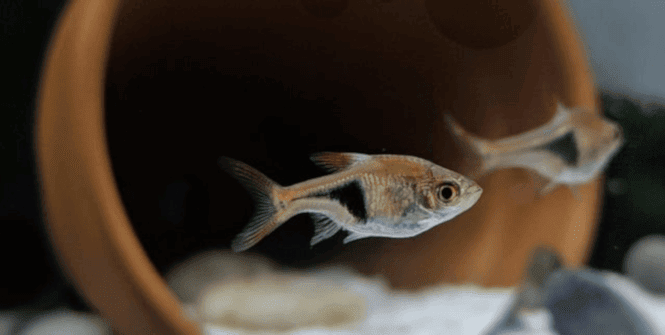
| Maximum Size: | 2 inches (5 cm) |
| Suggested Tank Size: | at least 10 gallons, but preferably 20 gallons |
| Suggested Water Temperature: | 70.7 to 84.2°F (21.5 to 29°C) |
| Suggested pH range: | 5.8 to 7.7 |
The Harlequin Rasbora is the easiest nano fish to breed. All they require is a clean tank and regular execution of a proper diet.
The harlequins are also in high demand, so you won’t have to tire yourself looking for them since many pet stores have them in stock.
Harlequin rasboras belong to the Trigonostigma genus and are so easy to keep that I actually listed them in my article on the easiest fish to take care of. If you’re a beginner in the hobby and want to have a low-maintenance home aquarium you should probably give that a read.
However, these nano pet fishes are popular not because they are easy to maintain but due to their impressive schooling behaviors and vibrant colors.
They add great beauty and activities to the tank; their darker orange-red fins intensely change color, and it is fun to watch, the least.
The change is triggered by various factors like the conditions of the tank and the level of stress they experience.
If alone, the Harlequin Rasbora is hesitant and dull.
Harlequin Rasboras is best kept in groups of at least six individuals, as they exhibit natural schooling behavior in the wild.
When choosing tank mates for Harlequin Rasboras, it’s essential to choose species that have similar tranquil temperament and are compatible with their water parameters.
Popular tank mates for Harlequin Rasboras include other small, peaceful fish species that inhabit similar tropical freshwater environments. This includes species such as tetras (e.g., Neon Tetras, Ember Tetras), dwarf corydoras catfish (e.g., Corydoras habrosus, Corydoras pygmaeus), and small species of loaches (e.g., Dwarf Chain Loaches).
In fact, they are harmless to a fault as sometimes other bigger mates do take advantage of the Harlequins, turning them into regular meals.
Carefully choose which aquarium inhabitants these rasboras co-exist with.
I have seen them live comfortably with snails and shrimp.
Some reports confirm that Guppies and Platies can also do but I have not had the chance to put them together.
The Harlequin Rasbora size generally reaches up to 2 inches (5 centimeters) and keeps that as its standard body length.
A high variation of maximum size has not been observed for this fish.
Though Harlequin Rasboras are not the best for a small aquarium of 3.5 or 5 gallons they will perfectly suit a 10-gallon community fish tank.
In smaller fish tank sizes, there’s not enough swimming space to guarantee a comfortable residence for a healthy number of schooling individuals.
Recent breeding successes with Harlequin Rasboras (Trigonostigma heteromorpha) in home aquariums have been achieved by gaining an understanding of their natural spawning behaviors and providing optimal breeding conditions.
Aquarists have found that creating an environment that closely resembles their native habitat in Southeast Asia is crucial for inducing breeding behavior. This involves maintaining water parameters such as temperature, pH, and hardness within the species’ preferred range, which typically includes slightly acidic to neutral water with temperatures around 75-80°F (24-27°C).
Abundant hiding places and well-kept vegetation further promotes natural spawning behaviors. Provide fine-leaved plants like java moss or spawning grass for the fish to deposit their eggs.
Being omnivorous, Harlequin Rasboras dine on whatever comes their way, but they seem to enjoy plant detritus and insect eggs.
Recent genetic research has pinpointed the specific responsible for the characteristics coloration of Harlequin Rasboras. Scientists have identified the genes responsible for the pigment production and distribution in the fish’s skin cells.
Comprehending the genetic diversity of Harlequin Rasbora populations is crucial for conservation efforts aimed at preserving wild populations and maintaining healthy captive stocks.
5. Dwarf Pea Puffer – Carinotetraodon travancoricus

| Maximum Size: | 1.5 inches (3.8 cm) |
| Suggested Tank Size: | for a lone specimen – 10 gallons, but a heavily planted 5-gallon tank is also okay. |
| Suggested Water Temperature: | 76 to 78°F (24.4 to 25.5°C) |
| Suggested pH range: | 7.0 – 7.5 |
The Dwarf Pea Puffer from the Carinotetraodon genus is a small green fish with an insatiable appetite. Dwarf Pea Puffers originate from the freshwater environments of South India, particularly found in the Western Ghats region. Within this area, they reside in slow-moving streams, rivers, and flooded rice paddies with dense vegetation and sandy or muddy substrate.
This species is well adapted to the warm, tropical climate of their native habitat.
The Dwarf Pea Puffer is rightly named for its small size and compact body, making it a charming choice for freshwater aquariums. These puffers usually exhibit a rounded body shape with smooth, shiny skin and vibrant coloration.
Their colors can range from shades of green, yellow, brown, to even a mottled pattern, providing a visually appealing display in aquariums.
Dwarf Pea Puffers are tiny, carnivorous fish feeding on a variety of small invertebrates such as insect larvae, crustaceans, and snails. In aquarium settings, they show a strong liking for live prey, eagerly hunting down small crustaceans, worms, and insect larvae offered as food.
Given the chance, it can easily eat more than 6 blood worms per feeding and then beg for more.
This behavior often leads to overfeeding since many inexperienced fish keepers believe their puffers are still hungry. Unsurprisingly, the amount of waste this oddball nano fish produce is commensurate with their hunger.
Preventing overfeeding and managing water quality are crucial aspects of aquarium care. Below are some advance techniques to achieve these goals:
1-Feeding schedules and Portion control: Consider using automatic feeders or feeder rings to provide a precise amount of food at set times.
2-Observation and Monitoring: Look for signs of overeating, such as distended bellies or sluggish behavior.
3-Target feeding : Use feeding tongs or pipettes directly to feed individual Dwarf Puffers, allowing them to eat without being disturbed by other fishes.
4-Biological Filtration and Water Circulation: Invest in a high-quality filtration system with adequate biological filtration capacity to handle the bio-load generated by Dwarf Pea Puffers.
This is why a single pea puffer requires between 5 and 10 gallons of free space, despite its minuscule size. Since they can be quite aggressive, these freshwater puffers aren’t the best fit for a nano community tank.
Tank Setup Requirements:
- Aquascape: Use live plants like Java moss, Java fern, and Anubias to furnish the tank with hiding spots and visual obstacles. Dense vegetation helps decrease stress by offering shelter and breaking lines of sight, minimizing confrontations between puffers.
- Substrate: Select a fine-grained medium like sand or smooth gravel to replicate the puffers’ natural atmosphere. Rough or sharp substrates can harm their delicate bodies.
- Decor: Incorporate driftwood, rock formations, and PVC pipes to create additional hiding spots and territorial boundaries within the tank.
- Filtration and Water Circulation: Install a reliable filtration system with gentle water flow to maintain water quality and oxygenation without causing excessive turbulence.
- Tank Lighting: Use floating plants or adjustable LED lights to control the intensity and duration of illumination.
When selecting Dwarf pea puffer tankmates, look for species that are similar in size, temperament and water conditions. Suitable tankmates include:
- Small, peaceful freshwater fish such as small tetras, rasboras, and dwarf corydoras.
- Shrimp species like cherry shrimp or amano shrimp, which can coexist peacefully with Dwarf Pea Puffers in a well-planted tank.
- Snails such as nerite snails or Malaysian trumpet snails, which help keep the substrate clean and provide enrichment for the puffers.
In some cases, they might even provoke or attack larger fish.
So, if you’re going to keep them in a nano tank, it would be best to have them as solitary aquarium fish.
Fortunately, Dwarf pea puffers are one of the few fish that can live alone in a small tank.
Author’s note: When a Dwarf pea puffer feels threatened, it inflates itself by sucking in water. This increases its size and makes it harder to swallow by predators.
6. True Freshwater Bumblebee Goby – Brachygobius xanthomelas
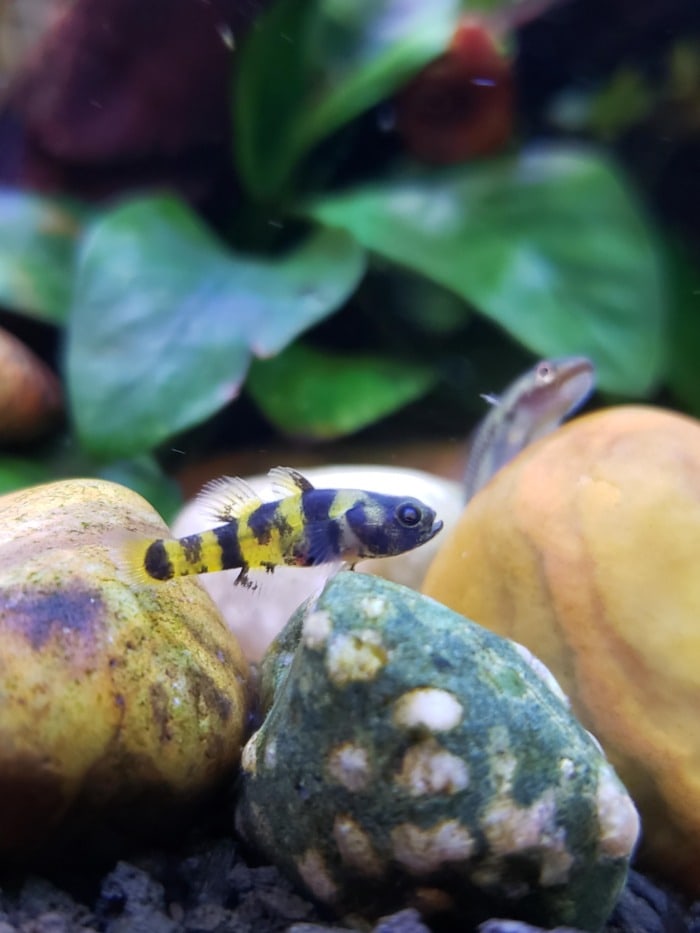
| Maximum Size: | 1.2 inches, but they usually stay under an inch (2.5 to 3 cm) |
| Suggested Tank Size: | 10 gallons |
| Suggested Water Temperature: | 71.6 to 82°F (22 to 28°C) |
| Suggested pH range: | 7.5 to 8.5 |
The True Freshwater Bumblebee Goby is a micro fish that typically stays under an inch when fully grown. Because of this species’ somewhat territorial behavior, the minimum size for its tank should be 10 gallons.
The Bumblebee Goby is assigned to the Brachygobius genus.
The freshwater Bumblebee goby fish are native to freshwater habitat of Southeast Asia, particularly found in rivers of and streams of Indonesia and Malaysia.
Recent studies have confirmed they favor shallow, slow-moving waters with sandy or muddy substrates.
These Bumblebee Gobies are very territorial and establish little territories within their preferred microhabitats. They exhibit complex social behaviors, including courtship displays, territorial disputes, and hierarchical interactions within groups.
True Freshwater Bumblebee Goby can be territorial and will try to fight off fish in its weight category.
Also, males will be especially territorial among each other.
However, I recommend getting at least six specimens.
This way the aggression will be spread among themselves, and the Bumblebee Goby group can be housed alongside other fish.
I would also recommend avoiding housing a True Freshwater Bumblebee Goby with any fish with longer fins such as goldfish, tetras, or smaller long-finned species.
A Bumblebee Goby that’s not in the mood may nip at its tank mates’ fins.
It’s not a risk worth taking, in my experience.
Researchers have documented the mating behavior of True Freshwater Bumblebee Gobies in their natural habitat. Breeding usually takes place during the wet season when water levels rise, stimulating spawning behaviors. Male gobies construct and defend nests in sandy substrates, where females deposit adhesive eggs.
Identifying True Freshwater Bumblebee Gobies (Brachygobius xanthomelas) from other similar species requires careful observation of specific physical attributes and behavioral traits.
Bumblebee Gobies usually have unique color patterns with horizontal stripes of black, yellow or gold on their body.
Generally, have dorsal and anal fins that are positioned posteriorly on the body, with a rounded or slightly pointed shape.
Introducing True Freshwater Bumblebee Gobies (Brachygobius xanthomelas) into home aquariums requires careful techniques for acclimating and introducing these gobies into aquariums:
Drip Acclimation Method: The drip acclimation is a gradual approach that minimizes stress and shock when introducing True Freshwater Bumblebee Gobies to new aquarium environments.
Begin by placing the sealed bag containing the gobies into the aquarium water, allowing it to float for an estimated duration of 15-20 minutes to achieve equilibrium temperature. Then, unfold the bag and secure it to the rim of the aquarium. Use airline tubing and a control valve to create a slow drip from the aquarium into the bag, gradually adding small amounts of aquarium water over the course of 1-2 hours.
Quarantine Protocol: Implementing a quarantine protocol is crucial for preventing the entry of pathogens and diseases into the main aquarium. The quarantine usually spans for a period of 2-3 weeks , during which time gobies should be closely monitored for any signs of illness or disease .
Author’s note: This fish will likely not accept commercial foods. You’ll need to provide it with either a live culture of micro bugs or frozen foods.
Anyway, I need to point out that you will never see this fish labeled as “True Freshwater Bumblebee Goby” in your local fish store. That’s because there are many fish species known as Bumblebee Goby and almost all of them actually inhabit brackish water.
Before putting this fish in a freshwater tank, always make sure it’s the right variety. Resorting to a reliable fish ID website such as SeriouslyFish is usually a good idea, when you’re not certain about a species.
Also, some of the more responsible online fish stores will have the True Freshwater Bumblebee Goby in stock. Visit this link to check some of these online fish stores.
7. Galaxy Rasbora – Danio margaritatus

| Maximum Size: | around 1 inch (2.5 cm) |
| Suggested Tank Size: | 10 gallons and above |
| Suggested Water Temperature: | 71°F – 78°F (21.6°C – 25.5°C) |
| Suggested pH range: | 6.8 to 7.5 |
Coming from the Danio genus, the Galaxy Rasbora, also known as celestial Pearl Danio, is yet another tiny freshwater aquarium fish species.
“Galaxy,” is a small and visually appealing freshwater fish that originates from Myanmar (Burma). It gained popularity in the aquarium hobby due to its vivid colors and unique patterns.
Galaxy Rasboras has a sleek body shape with a slightly arched back and forked tail fin. They exhibit a lively and active swimming behavior, often darting around the aquarium in small schools.
I love it mostly for its cool-looking colors which, at times, seem too stunning to be real.
I’ve also listed this fish in my compilation posts of the most colorful and the coolest freshwater fish for aquariums. Visit the link to check those out as there are some really cool mentions there, worth knowing about.
Although the different sexes of Galaxy Rasboras have different colorations, they nevertheless share orange, white, or golden spots (sometimes strips) spread all over their dark blue or black body color.
They also have transparent gill plates through which you can see their blood vessels.
The Galaxy Rasbora has been considered as one of the best small cold water fish since its discovery in 2006.
The lifespan of Galaxy Rasbora fish (Danio margaritatus) typically ranges from 2 to 4 years in captivity under optimal conditions.
It grows very small, up to 1 inch long for an adult specimen.
However, it has become a hot cake in the aquarium industry.
It is in such massive demand that its population now declines due to overfishing or the destruction of its natural home.
For that reason, this fish faces extinction.
Efforts to conserve Galaxy Rasbora and its habitat involve projects that focused on habitat conservation, restoration, regulate collection practices, and promote sustainable aquaculture. Efforts must be made to increase the knowledge about the endangered species’ conservation status and promote responsible aquaculture practices have also been undertaken.
These are schooling fish, so I advise that you keep them in a group of about 6 specimens for a 10-gallon fish tank.
This way, they can shoal comfortably.
For selecting Galaxy Rasboras tankmates, it’s important to choose species that are compatible in terms of temperament, size, and water parameters.
Species such as Neon Tetras, Ember Tetras, and Green Neon Tetras, Dwarf Rasboras like Chili Rasboras or Harlequin Rasbora,Pygmy Corydoras or Dwarf Corydoras as make excellent tank mates for Galaxy Rasboras.
Also, put in plants to give them cover, for they are quite timid.
Set your heater at 23°C and the pH at 7.
Galaxy Rasboras is relatively hardy and versatile, making them well-suited for community aquariums with peaceful tank mates. They flourish in well-maintained aquariums essential to mimic the species’ native environment and promote their health and well-being.
- Aquascape with Live Plants: Including live plants such as Java moss, Java fern, Anubias, and Cryptocoryne species to copy the dense vegetation found in the natural habitat of Galaxy Rasbora.
- Provide Dense Vegetation: Use driftwood, rocks, and aquarium decorations to create caves, crevices, and overhangs where the fish can seek refuge and explore.
- Use Natural Substrate: Natural substrate such as fine sand or gravel to mimic the sandy or muddy substrate found in the innate habitat of Galaxy Rasbora.
- Subdued Lighting: Use floating plants, floating driftwood, or adjustable LED lights to create dappled lighting effects and shaded areas where the fish can feel secure
Regular water changes and maintenance help ensure optimal water quality and a healthy environment for Galaxy Rasboras care.
Do not worry too much about bright light because they are used to direct sunlight in their natural habitat but try to make it moderate if possible.
Let’s talk about the Galaxy Rasbora Breeding:
Breeding techniques have played a vital role in supporting sustainable captive populations of Galaxy Rasbora (Danio margaritatus), alleviating the pressure on wild populations and aiding in their conservation. Here are some key advancements in Galaxy Rasbora breeding:
Selective Breeding for Desired Traits: Breeders have enhanced the visual attractiveness of these fish in the aquarium trade by selectively breeding pairs with brilliant colors and unusual patterns to produce offspring with even more beautiful appearance.
Artificial Incubation Methods: Advancements in artificial incubation methods have enabled breeders to improve the survival rates of Galaxy Rasbora fry and increase overall breeding success. Using the methods such as egg collection and artificial hatching allow breeders to closely observe the development of eggs and larvae
Although it can peacefully live in a nano tank with its other mates, the galaxy rasbora can only thrive and be vibrant in stable water conditions, so the dedicated care of a somewhat expert is needed.
8. Gulf Coast Pygmy Sunfish – Elassoma gilberti
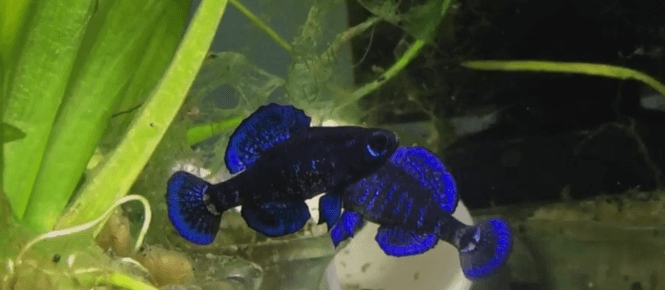
| Maximum Size: | 1 inch (2.54 cm), but the majority remain at 0.98 inches (2.48 cm) |
| Suggested Tank Size: | 5 gallons or more |
| Suggested Water Temperature: | 68 to 74.3°F (20 to 23.5°C) |
| Suggested pH range: | 6.5 to 7.5 |
Gulf Coast Pygmy Sunfish are native to the southeastern United States, particularly coastal regions around the Gulf Coast. They dwell in shallow, slow-moving freshwater habitats such as marshes, swamps, ponds, and backwaters.
Gulf Coast Pygmy Sunfish have a slender, elongated body with rounded fins and a small mouth. Sexual dimorphism is evident in this specie, as male generally showcase more vivid colors and more elaborate fins than females.
The Gulf Coast Pygmy Sunfish is another small pet fish with a stunning appearance that you should consider for your home aquarium.
It is one of the seven species that make up the Elassoma genus.
This Pygmy Sunfish is the shortest of the species as it grows to a maximum of 1 inch (2.54 cm) long, but the majority of specimens remain at 0.98 inches or 2.48 centimeters.
The other 6 species of sunfish range between 1.2 to 1.3 inches.
The Gulf Coast sunfish was discovered in 2009.
It has similar features to her cousin Elassoma Okefenokee and for a long time, I couldn’t quite tell which is which.
These dwarf fish are beautiful and easy to keep as long you maintain them in the right conditions. The dominant male is especially stunning to watch while coloring up to claim territory, they turn electric blue and black.
To ensure the health and well-being of Gulf Coast Pygmy Sunfish (Elassoma gilberti), aquarists should follow recommendations for an optimal diet
Varied Diet: Gulf Coast Pygmy Sunfish are omnivorous and need a diverse diet to fulfill their nutritional requirements.
Small Live Foods: Gulf Coast Pygmy Sunfish have small mouths and have difficulty eating large food items. Offer small live foods such as baby brine shrimp, micro worms, and daphnia to guarantee easy consumption and digestion.
Feeding Frequency: Feed these tiny aquarium fish small amounts multiple times a day rather than a single large meal.
Avoid Overfeeding: Avoid overfeeding Gulf Coast Pygmy Sunfish, as excess food can lead to water quality issues and digestive problems. Only provide them with what they can consume within a few minutes.
From what I have observed and gathered from other aquarists, these fish tend to demand live food like micro-worms and insects over prepared food. They will also predate and feed on small snails and snail babies.
This is critical as they are mainly wild-caught.
When selecting suitable tank mates and community setups for Gulf Coast Pygmy Sunfish (Elassoma gilberti) one should take into account their small size, calm temperament, and specific habitat requirements. Here’s an overview:
Tank Mates:
Species such as White Cloud Mountain Minnows and Ember Tetras ,Dwarf Rasboras: Chili Rasboras and Dwarf Emerald Rasboras ,Otocinclus Catfish (Otocinclus affinis) , Cherry Shrimp and Nerite Snails These small, peaceful fish share similar water parameter requirements and occupy different levels of the aquarium
Community Setups:
A densely planted aquarium with soft water is also necessary because it is a resemblance to their natural habitat in the wild.
Planted Aquariums: Use a variety of live plants such as Anubias, and Cryptocoryne species to create hiding spots and cover for the fish.
Natural Décor: Add in driftwood, rocks, and leaf litter to create a realistic environment for Gulf Coast Pygmy Sunfish. s.
Gentle Water Flow: Gulf Coast Pygmy Sunfish prefer slow-moving water with gentle water flow. Use a low-flow filtration system or position filter outlets to create tranquil zones within the aquarium.
Minimal Lighting: These sunfish are habituated to dimly lit environments in their natural habitat. Use subdued lighting or floating plants to diffuse light.
Calm water will be greatly appreciated by the Gulf Coast Pygmy Sunfish.
The males put on intense and impressive colors, especially during the mating season (which is pretty much constantly after they become comfortable enough).
Research on the behavior and social interactions of Gulf Coast Pygmy Sunfish (Elassoma gilberti) has shed light on the intriguing social dynamics :
Gulf Coast Pygmy Sunfish display a hierarchical social structure within their inhabitants.
Gulf Coast Pygmy Sunfish are extremely territorial and show aggressive behaviors towards those who try to invade their territory. Male sunfish, in particular, are known to defend their territory vigorously, engaging in confrontations and displays of dominance to assert their territory boundaries.
Now regarding the courtship and reproductive behavior, researchers have uncovered that males perform elaborate courtship displays , including fin displays circling movement and vibratory signals in order to attract females and establish mating pairs .
The tiny aquarium fish is a survivor – it requires low oxygen, unlike some other fish.
It will acclimate to a wide range of water parameters and the only thing that’s required for it to spawn is a constant supply of live food.
A Ph of around 7-8 is okay.
You should set your water temperature at 23°C.
A 5-gallon aquarium is comfortable for a pair of Gulf Coast Pygmy Sunfish.
A 10-gallon tank can comfortably accommodate a modest school of this fish.
If you want to include other tankmates, consider a 20-gallon tank.
9. Dwarf Pencilfish – Nannostomus marginatus
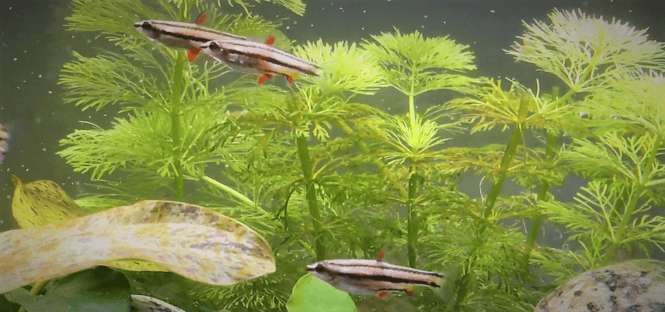
| Maximum Size: | 0.98 inches (2.5 cm) |
| Suggested Tank Size: | a minimum of 10 gallons to house a school |
| Suggested Water Temperature: | 73.4 to 82.4°F (23 to 28°C) |
| Suggested pH range: | 5.7 to 7 |
Dwarf Pencilfish (Nannostomus marginatus) are a captivating little freshwater fish highly valued by aquarists for their peaceful nature and impressive look. The Dwarf Pencilfish is a member of the Nannostomus genus.
Originating from the slow-moving tributaries and blackwater streams of South America, particularly in regions of Brazil and Guyana where they have adjusted to various aquatic environments.
Dwarf Pencilfish display a subtle yet astonishing appearance. Their bodies are elongated and slender, imitating the shape of a pencil, hence their name. The primary coloration of their body is typically silver or gold, with iridescent hues that shimmer in the light.
From what I have seen, the Dwarf Pencilfish are very active, especially in blackwater aquarium conditions where they tend to be more at home.
Lower the lights, though, as they are no fans of bright lighting.
You can use floating plants to absorb the lighting and create some shadowing.
The Dwarf Pencil also enjoys low currents so the filtration should be modest.
Studies have delved into their natural habitat and behaviors to customize their diets in captivity for optimal health and vitality.
Dwarf pencil fish are mainly omnivorous , feeding on both plants and small aquatic invertebrates .
Commercial fish flakes and pellets can serve as staples, supplementing their diet with white worms and micro worms .
It is essential to incorporate plant-based foods into their diet. Dwarf Pencil fish are known to consume algae and aquatic vegetation in the wild, highlighting their requirements for fiber and plant material.
It is advisable that you keep them in a school of at least 10 members.
This makes them feel secure and confident enough to move around in the aquarium.
Of course, this calls for a 10-gallon tank at the very least.
I would also recommend that you only add them to a mature aquarium where stable water conditions can be guaranteed, as per my personal experience with these guys.
Maintaining blackwater conditions in the aquarium is essential for replicating the natural habitat of certain fish species like Dwarf Pencilfish.
- Aquarium Setup: Start by choosing an appropriately sized aquarium for your Dwarf Pencil fish. Aquarium tanks ranging from 10 to 20 gallons can accommodate a small group of these fish comfortably.
- Water Filtration: Select a gentle filtration system that mirrors the slow flow of water found in natural blackwater habitats. Avoid powerful currents that can stress the fish.
- Heating: Blackwater habitats frequently have slightly warmer water temperatures which is suitable for Dwarf Pencilfish and promotes their natural behaviors.
- Aquarium Decor: Use natural materials into your aquarium decor to recreate the dark, tannin-stained environment of blackwater habitats. Use driftwood, Indian almond leaves, and dried botanicals like catappa leaves, oak leaves, or alder cones.
- Substrate: Choose a dark-colored substrate such as sand or fine gravel to replicate the substrate found in blackwater streams and rivers.
Captive breeding of Dwarf Pencil fish can provide aquarists with the opportunity to cultivate and propagate this species.
Sexual Dimorphism:
Understanding the differences between male and female Dwarf Pencilfish is necessary for successful breeding. In comparison to female dwarf fish ,male Dwarf Pencilfish usually have more vivid colors and longer dorsal fins. During breeding readiness, males may exhibit more intense coloration and may develop a reddish hue on their fins.
Spawning Behavior:
Dwarf Pencilfish are egg scatterers, meaning they release their eggs randomly throughout the aquarium. During spawning, males will typically chase females and display courtship behaviors, such as flaring their fins and performing circular dances. The females may lay up to 100 eggs.
Egg Collection:
To increase the survival rate of the fry, it’s advisable to provide a separate breeding tank with fine-leaved plants or spawning mops where the eggs can be laid. After spawning, carefully remove the adult fish from the breeding tank to prevent them from consuming the eggs. It takes almost 32 -72 hrs for eggs to hatch.
The lifespan of Dwarf Pencilfish typically ranges from 3 to 5 years in captivity under optimal conditions
Typically, the Dwarf Pencilfish grow up to 0.98 inches (2.5 cm) which effectively classifies them as an aquarium type of fish that stays small even in their adulthood.
10. Dwarf Rasbora – Boraras maculatus
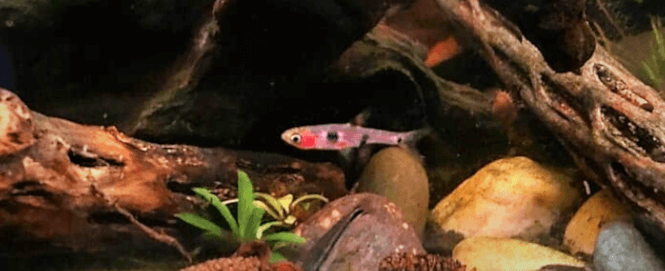
| Maximum Size: | 1 inch (2.54 cm), but most adult specimens will remain at around 0.75 inches (1.9 cm) |
| Suggested Tank Size: | 5 gallons or more for a school |
| Suggested Water Temperature: | 73.4 to 80.6°F (23 to 27°C) |
| Suggested pH range: | 4.7 to 6.2 |
Dwarf Rasboras also known as emerald dwarf rasbora typically possess slim, elongated bodies with rounded fins and a small mouth. Dwarf Rasboras are native to habitats in Southeast Asia, particularly regions of Thailand, Malaysia, Indonesia, and Myanmar.
The dwarf “Boraras” rasbora is one of the strikingly attractive tiny fish on this list.
The Dwarf Rasbora is considered a member of the Boraras genus.
Researchers have identified unique genetic signatures associated with distinct color morphs, such as the fiery red and golden hues seen in some individuals.
Especially the males’ bright ruby red color stands out in the aquarium pretty much like a rainbow in the sky.
The Emerald Dwarf Rasbora has become trendy because of its entertaining schooling behavior and its peaceful disposition.
The maximum life expectancy of the emerald dwarf is 3 to 5 years.
These qualities make it a fitting companion among other tank-mates.
There has been a notable increase in the availability of captive-bred Dwarf Rasbora (Boraras maculatus) specimens within the aquarium trade.
Emerald Dwarf Rasboras are now being bred in captivity by enthusiasts and commercial breeders in controlled environments, alleviating pressure on wild populations.
Furthermore, captive breeding enables the selection of healthier and more robust individuals, leading to better genetics and increased resilience to diseases compared to their wild-caught counterparts.
This pretty dwarf aquarium pet fish grows to a maximum of only 1 inch (2.54 cm), but the average standard size for a single specimen would be around 0.75 inches (1.9 cm).
Such a size essentially makes the Dwarf Rasbora one of the smallest fish in the aquarium trade.
If you are not a fish expert, you could hardly differentiate it from its cousin, the Chili Rasbora.
I once heard some suspicious buyers whisper that the two are actually the same species from different environmental conditions.
I just chuckled.
The Boraras Maculatus thrives best on varied meat food: bloodworms (I suggest you chop them), microworms, etc.
You should also maintain the water clean and use floating plants to keep the light dim as this micro fish does not really like bright lighting.
The Dwarf Rasbora is the smallest schooling nano fish for home aquariums.
With a full size of 0.75 inches or 1.9 cm per specimen, these fish can comfortably school in a tiny 5-gallon tank.
However, they easily get stressed and distracted from shoaling when housed together with harassing tankmates.
So if you must keep them in a community tank, find agreeable tank mates like the dwarf shrimp , nerite snails and Malaysian trumpet snails.
Also, provide hiding places in the form of aquarium decoration or live plants just in case they are frightened (which is bound to happen once in a while).
Dwarf Rasboras prefer the middle or top level of a fish tank’s water column.
A 6-gallon fish tank is more than suitable for a small school of this micro fish species. These fishes are kept in groups of 8 to 10 at least .
For the aquarium parameters, I recommend you set the heater at 25°C and maintain a pH of around 5 (acidic water).
Natural Substrate: Use a fine-grained substrate such as sand or smooth gravel to recreate the sandy or muddy substrate found in the natural habitat of Dwarf Rasboras.
Plantscape: Choose a variety of aquatic plants such as Java Moss, Java Fern, Anubias, Cryptocoryne, and Rotala species to create lush, naturalistic scenery.
Floating Plants: Include floating plants such as Water Sprite , Water Lettuce , or Amazon Frogbit to provide additional cover and shade for Dwarf Rasboras.
Driftwood and Rocks: These features create hiding spots, territorial boundaries, and naturalistic habitats for Dwarf Rasboras and other aquarium inhabitants.
Aquatic Layout: Use the “rule of thirds” to divide the aquarium into foreground, midground, and background zones, with taller plants and decorations placed towards the back to create depth and perspective.
Water Flow and Filtration: Use a gentle filtration system and position filter outlets to create gentle water movement and circulation without causing excessive turbulence or strong currents.
Subdued Lighting: Use adjustable LED lights or floating plants to create dappled lighting effects and shaded areas where Dwarf Rasboras can feel secure.
11. Pristella Tetra – Pristella maxillaris
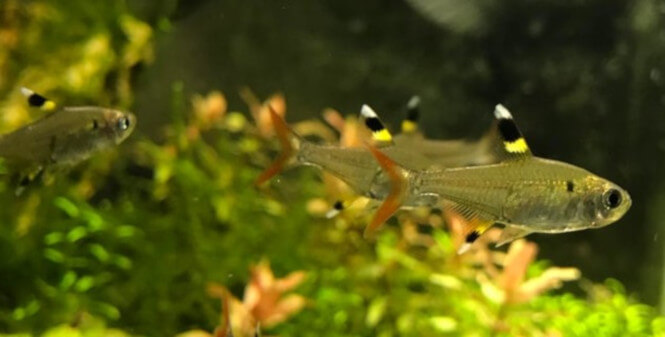
| Maximum Size: | 1.9 inches (4.8 cm) but most adults will remain at around 1.7 inches (4.3 cm) |
| Suggested Tank Size: | 10 gallons at the absolute minimum, but preferably 15 gallons |
| Suggested Water Temperature: | 74 to 82°F (23.3 to 27.7°C) |
| Suggested pH range: | 6.2 to 7.5 |
Pristella Tetras are another tiny fish I wholeheartedly recommend for a beginner aquarist.
These small tetra fish are part of the Pristella genus. The Pristella Tetra (Pristella maxillaris), commonly referred as the X-ray Tetra or the Golden Tetra, plays a significant ecological role in its native habitat, primarily in the freshwater streams, rivers, and flooded forests of South America, particularly in the Amazon River basin.
I love watching these Golifish pristella tetras as they have lovely round bodies and a black strip right across the dorsal fin. They honestly remind me of small sharks and are really the closest thing you could get at this size that would resemble a freshwater shark.
In their native territory, Pristella Tetras occupy a distinctive ecological niche as mid-water dwellers. They form shoals or schools of dozens to hundreds of individuals, aggressively searching for food and seeking shelter among aquatic plants and submerged debris.
Pristella Tetras plays a crucial role in the food web as both predator and prey, feeding on small invertebrates, algae, and plant matter, while also serving as food for larger fish species.
Anyway, Pristella tetras, unlike sharks, are very peaceful when being kept in a small school of, say, 6.
They possess somewhat transparent bodies for which they are sometimes called “X-ray” tetras.
The life expectancy of Pristella tetras is 4 to 5 years .
However, Corydoras make perfect companions for them since both species are peace lovers.
Advancements in captive breeding and rearing techniques for Tetras Pristella have greatly improved the accessibility and long-term viability of these popular freshwater fish:
Selective Breeding Programs: Enthusiastic breeders have established selective breeding programs to improve desired characteristics such as coloration, finnage, and overall health in captive bred Pristella Tetras.
Induced Spawning Techniques: Breeders use different induced spawning techniques to stimulate breeding behavior and initiate spawning in captive Pristella Tetras. Methods such as temperature manipulation, water parameter modifications, and hormone injections.
Nursery Rearing Systems: Specialized nursery rearing systems have been especially designed to provide ideal conditions that promote the growth and development of Pristella Tetra fry (young fish)
The pristella tetra size is about 1.9 inches or 4.8 cm if they are kept under healthy conditions.
The smallest aquarium size I recommend for housing them is 10-gallons of water for living space.
Pristella tetras are restless schooling fish so they need the swimming space.
Providing enrichment and stimulation for Pristella Tetras in the aquarium is essential for encouraging their natural behaviors and improving well-being. Here are some tips for aquarists to consider:
Aquascaping with Plants and Decorations: Establish natural setting environment by including live plants such as Java Moss, Java Fern, and Amazon Swordplants and other decorations.
Aquarium Lighting: Give appropriate lighting conditions that mirror the natural day-night cycle.
Floating Plants: Incorporate floating plants like Water Sprite or Amazon Frogbit to provide additional cover and shade for Pristella Tetras
Water Flow and Aeration: Golifish Pristella Tetras prefer slow to moderate water flow in the aquarium. Use adjustable filtration systems and air pumps to control water movement and aeration, ensuring a comfortable and oxygen-rich environment for the fish.
Interactive Feeding: Engage Pristella Tetras in interactive feeding sessions by using feeding rings or floating food dispensers.
12. Rosy Loach – Tuberoschistura arakanensis
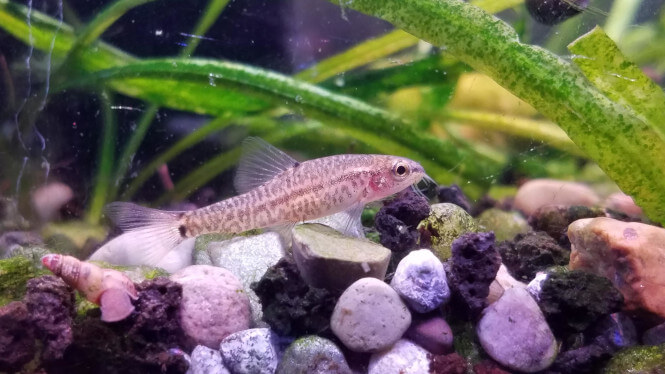
| Maximum Size: | 1.2 inches (around 3 cm) |
| Suggested Tank Size: | 30 gallons because of how active these micro fish are in the aquarium |
| Suggested Water Temperature: | 69 to 78°F (20.5 to 25.5°C) |
| Suggested pH range: | 6.7 to 7.8 |
The Rosy Loaches are representatives of the Tuberoschistura genus.
First, I suspect this scientific name is fictitious, but let’s go with it.
Secondly, I have for five years had Rosy Loaches in one of my aquariums so I can speak from personal experience here.
Rosy Loaches fish are commonly known as stone loaches or hillstream loaches.
These fish are identified by their rosy-pink coloration, slender body, and distinctive markings along their sides. They derive from the habitats of Southeast Asia, particularly in the Arakan Hills region of western Myanmar (Burma).
The life expectancy is around 6 to 8 years.
Rosy Loaches are commonly found in shallow, clear-water streams with rocky bottoms and moderate to fast water flow. Their habitat preferences include areas abundant in submerged vegetation, rocky crevices, and overhanging vegetation, which provide shelter, breeding sites, and foraging opportunities.
Rosy Loaches are omnivorous and opportunistic feeders, consuming a varied diet consisting of algae, small invertebrates, insect larvae, and organic matter.
What impressed me most when I just had these small fish was how fast they adapted to the new environment without any hitches.
Now, they are really charming and hyperactive, especially when in a large school.
By the way, all loach families should be kept in large groups if you don’t wish to see them withdraw.
This means keeping them in large groups of at least 10 specimens.
Because of their endless curiosity, your aquarium should have plenty of plants, driftwood, and rockwork to be lively for them.
Yet, you still have to leave enough clear space for shoaling, especially in mid-water as rosy loaches are middle to bottom aquarium dwellers. Hanging out on the bottom also means that you should be very careful if you want to pair them with other small bottom dwellers like the tiny pleco species. Most plecos are territorial, be they small or large.
I have noted that they rarely prey on snails though.
Maybe just my Rosy Loaches are nice to snails.
I am yet to find out if this is a universal phenomenon.
Maintain them with a fleshy diet supplemented with vegetables if you want to enjoy watching their vibrant orange coloration.
There was a time I would feed them mosquito larvae, and they loved it.
Another unique aspect I have observed with them is this constant power struggle.
Each of them wants to be the leader of the group.
However, this competition to be in charge rarely ends up in a fight.
This is a lesson we humans should emulate, maybe.
I have also observed that at other times some of them form distinct territories that are supposed to be no-go zones of sorts.
That’s how unusual some of their behavior can be.
I keep my Rosy Loaches at 77°F ( 25°C) temperature of the aquarium water.
Ensure that the aquarium is well-oxygenated and has ample hiding locations like rocks, caves .
Incorporate live plants such as Vallisneria to provide cover and grazing opportunities.
Now, this is where you look for a 30-gallon tank.
As I noted, these are hyperactive pet fish.
I would say that the longest Rosy Loach I have seen in my aquarium measures about 1.2 inches or around 3 cm.
13. Least Killifish – Heterandria formosa
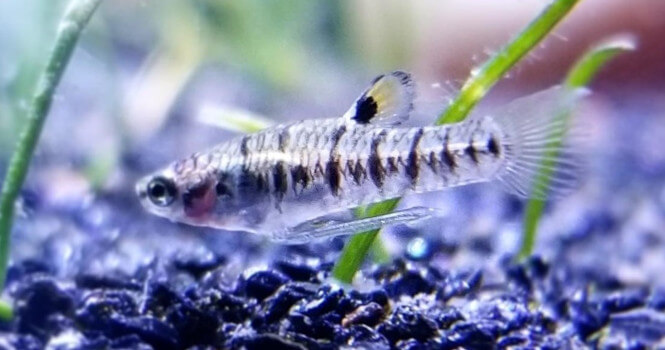
| Maximum Size: | 1.2 inches (3 cm) but in general, these fish will remain at around 0.8 inches (2 cm) |
| Suggested Tank Size: | 5 gallons and above |
| Suggested Water Temperature: | 68 to 78°F (20 to 25.5°C) |
| Suggested pH range: | 7.2 to 8.2 |
What’s in a name?
The irony here is that the Least Killifish doesn’t belong to the killifish family.
This small white aquarium fish is actually part of the Heterandria genus in the Poeciliidae family and is the 7th smallest fish in the world.
Least Killifish are native to the southeastern United States, specifically the coastal plains region from North Carolina to Florida. They dwell in slow-moving or still freshwater habitats such as marshes, swamps, ponds, and ditches.
Least killifish are tranquil and gregarious freshwater fish noted for their active behavior and lively swimming movements. They frequently gather in shoals or small groups, particularly when they are in a natural environment with appropriate tankmates.
Least killifish are small-bodied fish with elongated streamlined shapes.
They have a characteristic coloration, with males displaying vibrant hues of red, orange, and yellow, while females are typically duller in color.
Least Killifish have a distinctive feature called a gonopodium, which is a modified anal fin used for internal fertilization during mating.
The male is around 0.8 inches while the female is 1.3 inches.
The lifespan is around 1.5 years to 3 years.
The Least killifish is also the smallest livebearer fish in the world discovered to date. Unlike other livebearers, which produce all the fry at once during the breeding, the female Least Killifish produces hers sparingly.
She brings forth about 3 fry babies every 5 to 10 days until she is finally done.
Her fry is bigger than the other livebearer fish’ fry.
Fertilization occurs internally, with females storing up sperm for later use in fertilizing eggs.
Least Killifish are prolific breeders and can produce year-round under favorable conditions.
Male Least Killifish exhibit courtship behaviors to attract females, including displaying vibrant colors, executing mating dances, and chasing females with swift movements. When a female is ready to mate , the male positions himself next to her and transfers sperm using his gonopodium. Females may exhibit cryptic coloration and submissive behaviors during courtship to avoid aggression from males.
The least killifish fish care is easy because it simply adapts to various water conditions.
Again, it is peaceful and friendly by nature (its name has nothing to do with killing) so it can coexist with other species.
Do not place alongside aggressive tank mates though.
The following setup will guarantee you excellent results for the least killifish care:
Establish a densely planted aquarium with fine-leaved plants like Hornwort.
Ensure consistent water parameters as fluctuations can lead to stress and hinder breeding.
Ph of 7.6 to 7.8, a temperature of 75°F (24°C), and a 3 to 5-gallon tank at the least.
Conservation efforts for the Least killifish concentrate on safeguarding their native environment and managing threats :
Habitat Preservation
Habitat Restoration: restoring riparian vegetation, replanting native aquatic plants, and implementing erosion control measures to stabilize stream banks and reduce sedimentation.
Water Quality Management: minimize water contamination and ensure the availability of clean, unpolluted water for wild populations.
Invasive Species Control: habitat modification, removal efforts, and biological control methods.
Community Engagement and Education
Legislation and Policy Advocacy: establishment of regulations, conservation incentives, and enforcement mechanisms to safeguard wild populations and their habitats.
14. Pepper Corydora – Corydoras paleatus
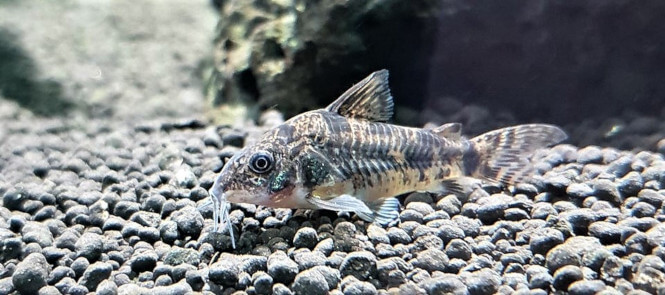
| Maximum Size: | 2.8 inches (7.1 cm) but most will stay at 2.5 inches (6.4 cm) |
| Suggested Tank Size: | 10 gallons at the very least |
| Suggested Water Temperature: | 72 to 79°F (22.2 to 26.1°C) |
| Suggested pH range: | 6.2 to 7.2 |
The Pepper Corydora is associated with the Corydoras genus of freshwater catfish.
Pepper Corydoras, sometimes called peppered cory catfish or salt and pepper corydoras, are one very relaxed freshwater fish and are a good choice for micro aquariums.
In fact, it’s peaceful and calm to the point it appears lazy.
What would you call a fish that hardly swims to the top, and instead is content with scourging the substrate for food or, perhaps, for fun?
I’d call it a down-to-earth fish. No, a-down-to-substrate fish…
Well, it hovers along the tank bottom and if it sights some food there, it charges for it at once like a rhino.
Watching it “hunt” for food is part of the fun for me.
Okay, it does come to the surface to gulp in oxygen from time to time as it has the ability to do so through special organs.
This characteristic enables it to survive in low oxygen conditions.
Still, on peace, I should point out that Pepper Corydoras are among the few fish types that never get aggressive with each other during mating.
I kind of respect them for that.
This dwarf fish originates from Brazil and Uruguay, but I have heard unverified reports that it has natural habitats in many other South American countries.
They are particularly abundant in the Rio de la Plata basin, which encompasses parts of Argentina, Uruguay, and Brazil, as well as the Paraguay and Parana river systems.
The pepper cory grows to a maximum size of 2.2 inches.
Life span is 3 to 5 years max .
A tank of at least 10 to 15 gallons is suitable for a pair of pepper cories.
Nevertheless, do not hesitate to use a 20-gallon tank.
In their natural homes, they feed on insects and plants so try to provide a similar diet for them in the aquarium.
The alternatives are regular live food and sinking pellets.
Pepper Corydoras (Corydoras paleatus) exhibit interesting social behavior and communication within their groups:
Group Dynamics: Pepper Corydoras are shoaling fish, meaning they instinctively form groups or shoals consisting of several individuals. In the wild, they are frequently seen in big groups , and they exhibit similar behavior in aquariums.
Schooling Behavior: Within the group, Pepper Corydoras engages in schooling behavior, swimming together in synchronized movements. Schooling helps them navigate their surroundings more effectively and gives a sense of protection.
Social Hierarchy: While Pepper Corydoras generally have a calm demeanor, they may establish social hierarchies within their group. Dominant salt and pepper Corydoras may take charge during feeding or breeding activities, while subordinate fish may defer to dominant individuals and steer out of conflict.
Communication: Salt and Pepper Corydoras communicate with each other through a variety of visual and tactile signals. They may use body language, such as fin displays or posture changes, to convey information about their intentions or emotions.
Chemical Signals: Like many other fish species, Pepper Corydoras also use chemical signals, or pheromones, to communicate with each other.
Keeping Pepper Corydoras (Corydoras paleatus) in community tanks provides numerous health benefits for the overall aquarium ecosystem. Here are some key points:
Algae Control: Pepper Corydoras are brilliant algae eaters and aid control algae growth in the aquarium.
Substrate Aeration: As bottom-dwelling fish, Pepper Corydoras sift through the substrate in search of food, which helps aerate the substrate and prevent formation of anaerobic pockets.
Tank Cleaning: Pepper Corydoras exhibit remarkable scavenging abilities , feeding on leftover food particles and decaying organic matter.
Stress Reduction
Natural Pest Control: Pepper Corydoras assist in managing the populations of small pest invertebrates, such as planaria and detritus worms, by consuming them as part of their diet.
15. Dario Dario – Badis bengalensis
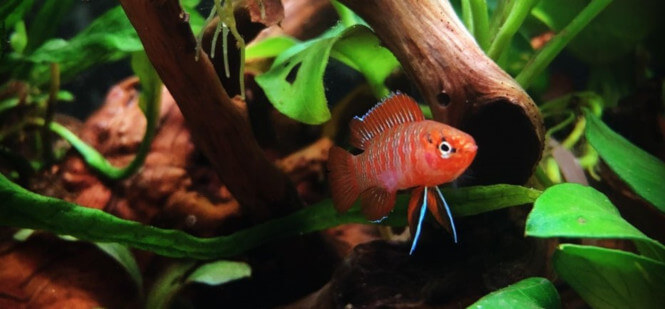
| Maximum Size: | 0.78 inches (2 cm) |
| Suggested Tank Size: | 5 gallons or more for a single male with 2 females |
| Suggested Water Temperature: | 68 to 78.8°F (20 to 26°C) |
| Suggested pH range: | 6.8 to 7.8 |
The Dario Dario is a small Indian fish or, to be more specific, a native of the Brahmaputra River.
Dario dario, commonly known as the Scarlet Badis, primarily found in freshwater habitats across India, Bangladesh, Nepal, and Bhutan. Within this region, it inhabits various aquatic environments, including slow-moving or stagnant waters such as streams, creeks, and shallow ponds.
This beautiful on the outside and timid by character fish comes from the Dario genus. An average adult is 0.8 inches so they can survive in a 5-gallon tank, or even less.
The male Dario Darios put on more coloration when wooing a female.
The most colorful male gets the lady.
It is found along the shallow shores that are dominated by vegetation.
So in your tank, put sand to mimic its natural habitat. Black sand is ideal as it makes the colors of our guys pop beautifully. Black Diamond Blasting sand is a safe and relatively cheap option.
The Scarlet Badis thrives in areas with dense vegetation and soft substrates, such as leaf litter, mud, and sand. It is commonly found in areas with ample of submerged vegetation, fallen branches, and other forms of cover, which provide shelter and spawning sites
According to some research I did, Dario fish might get aggressive and territorial.
Therefore, the tank you prepare for them should contain boundaries between them, especially males.
Put coconut shells to act as caves (read private territories) in the aquarium.
Driftwood is also a sound choice for decoration with these guys.
Again, they are not what I would call shoaling fish.
How do you shoal when you fight to the death over everything from food, mates to space?
But other times (rarely) they bury the hatchet and try to put up a show.
The health and longevity of Dario dario, commonly known as the Scarlet Badis or Scarlet Gem Badis, in captivity are influenced by various factors :
Tank Setup: Creating a biotope-inspired aquarium setup for Dario Dario
Substrate: Use a soft substrate like sand or fine gravel to copy the riverbed or stream bottom where Dario fish is found.
Décor and Hardscape: Ad natural décor items like driftwood, smooth rocks.
Aquatic Plants: Pick native aquatic plants that are found in the innate habitat of Dario dario. Species such as Cryptocoryne, and Vallisneria are suitable options.
Natural Additions: Enhance the biotope-inspired setup with natural additions such as floating plants, mosses, and algae mats.
Tank Mates:
Care should be taken when choosing tank mates for Dario as they are small and may be intimidated or harassed by larger or more aggressive fish. Suitable tank mates include other small, peaceful fish such as small rasboras, peaceful tetras, or dwarf shrimp. Avoid keeping them with large or aggressive species that may outcompete or prey on them.
Longevity:
With proper care, Dario fish can live in captivity for around 2-3 years.
Please do not get the impression that Dario are naturally hot-headed; they are peaceful as long as there are no others Dario to compete with.
16. Dracula Minnow – Danionella Dracula
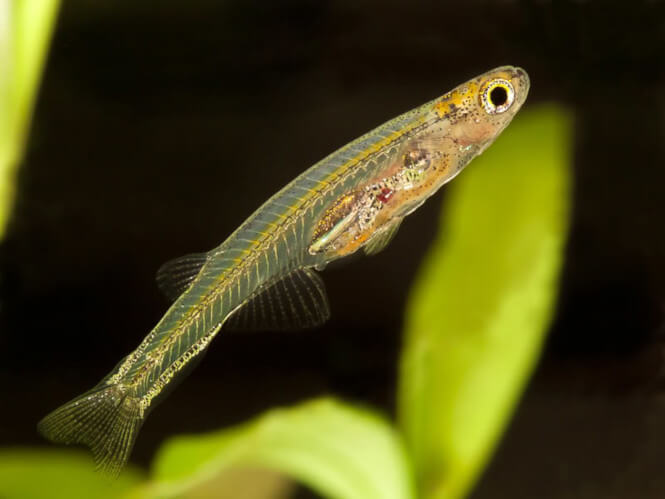
| Maximum Size: | the largest adult ever measured was 0.65 inches (1.67 cm) |
| Suggested Tank Size: | 5 gallons or more for a school of 10 |
| Suggested Water Temperature: | 66 to 78.8°F (19 to 26°C) |
| Suggested pH range: | 6.5 to 7.5 |
Coming from the Danionella genus, the Danionella Dracula is also known as the Dracula Minnow.
This is one of the few bizarre micro freshwater fish I have seen.
Its appearance can inspire or has undoubtedly inspired a horror film image.
This very small fish species was discovered in the pools in Myanmar, Burma, in April 2007.
An average Danionella Dracula adult is a mere 0.6 inches (1.5 cm) long.
If you are looking for some weird tiny fish to add to your beautiful freshwater tank as a contrast, go for this.
The horror features are their large eyes and unusual teeth.
Their teeth are virtually fangs made of protruding bones sticking out from the jawbones.
Males use these scary fangs for sparring.
The behavior and social dynamics of Dracula Minnows (Danionella Dracula) in the aquarium are intriguing to examine and understand. Here are some insights into their behavior:
Dominant fish may assert themselves during feeding and breeding activities, whereas subordinate fish typically yield to dominant individuals.
Dracula Minnows are active swimmers, constantly searching their environment and working together with tank mates. They may dart around the aquarium in search of food, playfully chasing each other, and engaging in mock fights or displays of dominance.
Males may establish territories and defend them against rival males to attract females for spawning.
Dracula fish are sensitive to changes in their environment and may exhibit stress or fear responses to sudden movements, bright lights, or loud noises.
Have I mentioned it is somewhat colorless?
You do not want to imagine what these dwarf fish would look like if it were the size of an adult dinosaur.
Again, it is not much of a threat to other tank mates despite its scary teeth.
Breeding Dracula Minnows (Danionella Dracula) in captivity can be challenging but rewarding. Here are some important and short points on breeding techniques and successful reproduction:
Distinguish between male and female Dracula Minnows. Males are usually smaller and more colorful, along with extended dorsal and anal fins, while females are larger and rounder bodied.
Spawning Stimulus: Initiate spawning response by triggering stimuli such as a slight decrease in water temperature, a significant water change with slightly cooler water, or the addition of spawning substrates like marbles or pebbles.
Courtship and Spawning: Male Dracula Minnows may display to females by expanding their fins and intensifying their colors.
Incubation Period: Eggs typically hatch within 24-48 hours, depending on water temperature.
Keep Dracula Minnows in a group of 6-8 individuals, with a balanced ratio of males to females.
It is easy to care for. It’s a schooling species so do not buy just one.
I advise you to go for a dozen.
Feed them on nematode microworms, Tubifex, or Daphnia. If you want, you can raise your micro-worms at a “farm” which is a great way to feed fish. To start the nematode farm you just need the following:
- a small plastic container
- some simple carb food like bread
- a starting culture (easy to find online)
- some yeast.
Tank setup :
Tank Size: Opt for a tank of at least 10 gallons to provide ample swimming space for Dracula Minnows.
Substrate: Use fine gravel or sand substrate to mimic their natural habitat and prevent injury to delicate fins.
Plants: Include live or artificial plants with fine leaves to provide hiding spots and mimic their natural environment.
Lighting: Use subdued lighting to replicate the dimly lit conditions of their native streams.
Filtration: Choose a gentle filtration system to maintain water quality without creating strong currents.
Decor: Incorporate driftwood, rocks, and caves to create hiding places and territorial boundaries.
Tank Mates: Select peaceful tank mates such as small rasboras, danios, or other peaceful community fish.
17. Chili Rasbora – Boraras brigittae

| Maximum Size: | 0.78 inches (2 cm) |
| Suggested Tank Size: | 5 gallons or more |
| Suggested Water Temperature: | 75 to 82.4°F (23.9 to 28°C) |
| Suggested pH range: | 4.5 to 6.8 |
The Chili Rasbora (Boraras brigittae) is a small, peaceful fish native to Southeast Asia, mainly found in the slow-moving streams and peat swamp forests of Thailand, Malaysia, and Indonesia. The Chili Rasbora belongs to the Boraras genus, same as the Dwarf Rasbora.
It is sometimes called Mosquito Rasbora and is a peaceful fish you could catch from the Indonesian rivers.
They are one of the best nano species of fish in terms of coloration, especially if you keep them in a larger group (like 10 or 12) where their confidence level is high.
An adult Chili Rasbora size is about 0.78 inches (around 2 centimeters) and is either red or orange.
Chili rasboras will best fit a small tropical fish tank.
They remain small in size even in adulthood and can adjust to a great range of temperatures.
Chilli rasboras are mainly omnivores, feeding on a diet of plant materials and tiny invertebrates. In the wild they consume microorganisms, algae and zooplankton.
Provide sinking food to the fish as they feed in the mid-water column.
The Chili Rasbora will thrive in aquarium water that mimics the conditions of tropical swamps.
The water in the fish tank should have a higher temperature of around 78°F (25.6°C) and a high acidity of, ideally, below 5.5 pH.
If you plan to house a school of these small red fish in a 5-gallon aquarium, I recommend checking my top picks for tiny water heaters. It also helps to put the Chili Rasbora fish together with tankmates of their size and temperament, such as dwarf Caridina shrimp and pygmy Corydoras.
Chili Rasboras enjoy feeding on daphnia, Cyclops, crushed fakes, or mini-bloodworms.
Since they come from a blackwater habitat, you’ll do them a great favor if you include floating plants or Indian almond leaves in your aquarium.
The floaters will cast shadows, and the Indian almond leaves will release tannins in the water, coloring it a darker tint while supporting the Rasboras’ immune system.
When pairing Chilli Rasbora for breeding, selecting healthy, mature individuals is best.
Chilli Rasboras may exhibit courtship behaviors such as chasing and displaying vibrant colors. Spawning usually occurs in the early hours of the morning, with females releasing eggs among fine-leaved plants or moss. It’s essential to provide plenty of hiding places for the eggs to prevent them from being eaten by the adults.
After spawning, remove the adult fish from the breeding tank to prevent them from consuming the eggs. Maintain stable water conditions and ensure proper aeration to support the development of the fry. The eggs will hatch about 24 to 36 hours, and the fry will emerge.
Preventing and addressing common health issues or ailments affecting Chili Rasboras in the aquarium:
Quarantine New Fish: Quarantine new fish before introducing them to the main aquarium to prevent the spread of diseases.
-Balanced Diet
-Avoid Overcrowding
-Quarantine and Treat Sick Fish
-Monitor Behavior
-Maintain Optimal Water Parameters
In my experience, the Chili Rasbora tends to be somewhat delicate and sensitive to swings in the aquarium water’s parameters.
Maintaining stable water chemistry is beneficial for the well-being of these fish.
Related: Learn more about how to take care of a Chili Rasbora fish.
18. White Cloud Mountain Minnow – Tanichthys albonubes
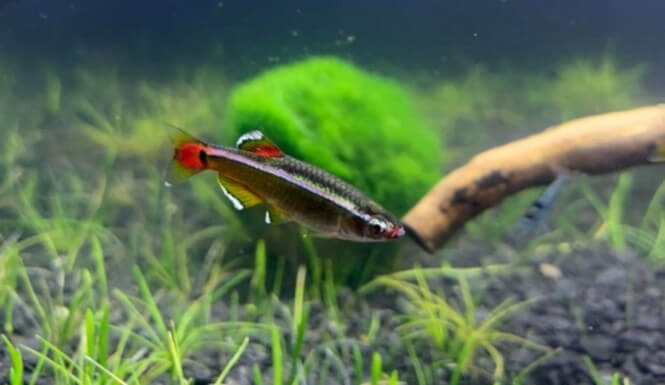
| Maximum Size: | 1.4 inches which equals 3.6 centimeters |
| Suggested Tank Size: | 5.5 gallons but a 10 gallon fish tank is preferable as the minimum |
| Suggested Water Temperature: | 59 to 71°F (15 to 22°C) |
| Suggested pH range: | 6.5 to 8.5 |
This microfish species from the Tanichthys genus was first collected by a Chinese boy scout leader who promptly named its genus.
This happened near White Cloud Mountain in China where they were initially spotted in the 1930s.
For a better coloration display, you should put The White Cloud Minnow also called the golden white cloud mountain minnow up against a dark substrate in a heavily planted aquarium.
White Cloud Mountain Minnows are the best nano fish for a cold water aquarium.
These small fish can tolerate temperatures as low as 41°F or 5°C in the wild.
These minnows will thrive in fish tanks with a temperature range of 59 to around 71°F (15 to 22°C).
Warmer temperatures would result in a short life and a weak immune system for the White Cloud Mountain Minnows.
They can also gradually adapt to challenging aquarium conditions.
To protect the natural habitat of White Cloud Mountain Minnows, conservation programs have directives on several vital approaches. First and foremost is habitat restoration, which involves restoring degraded areas and preserving critical habitats such as streams, ponds, and wetlands.
Breeding White Cloud Mountain Minnows is an enjoyable and rewarding experience for aquarists.
During courtship, males display vibrant colors and elaborate mating dances to attract females. Once fertilized, the eggs are adhesive and typically adhere to the plants or other surfaces in the tank. Remove the adult fish after spawning to prevent them from consuming the eggs. The eggs hatch within 48-72 hours,
Selective breeding programs are helpful in the development of new color variations and morphs of White Cloud Mountain Minnows.
One of the most notable outcomes of selective breeding efforts is the emergence of golden and albino variations of White Cloud Mountain Minnows
By selectively crossing individuals with unique traits, breeders have initiated variations such as mosaic patterns, speckling, and iridescence, thus increasing the diversity of available morphs.
This mini fish is so peaceful that it would rather eat the leftovers or even nothing than compete for food.
Its docile behavior, however, shouldn’t fool you.
If you do not shut the top of your aquarium, this seemingly timid tiny fish will sometimes jump out to its inevitable death.
They enjoy feeding on insect larvae, shrimp, or insects.
You can also feed them on flakes.
Though I said they could tolerate challenging aquarium conditions, I do not encourage you to stress them because they are survivors.
Your aquarium size shouldn’t be less than 5 gallons.
For white cloud mountain care ensure that water remains consistently at a temperature ranging from 64 ‘F to 72 ‘F(18-22°C) which is essential for white cloud mountain minnow as it must not be exceeded.
The longest White Cloud Minnow I have seen was about 1.4 inches; I do not think they grow beyond that.
Otherwise, the fish is easy to maintain and I would recommend it to a beginner who has yet to fully comprehend the wonders of fish-keeping.
The tank size and the composition of the fish community can influence the behavior and social interactions of White Cloud Mountain Minnows.
In small aquarium setups, typically those under 10 gallons, White Clouds may exhibit more hesitant behavior due to limited space and potential overcrowding. In confined environments, they display heightened stress levels and may be more prone to aggressive interactions with tankmates.
In contrast, White Clouds tend to exhibit more energetic behaviors in larger aquarium setups with ample space. Given ample room to swim and explore, they are likely to display their characteristic schooling behavior, forming tight groups and traveling as a unit throughout the tank.
White Clouds are also less likely to display territorial or aggressive behavior in larger tanks, as there is more space for individual fish to establish their territories and evade conflict.
19. Ember Tetra – Hyphessobrycon amandae

| Maximum Size: | 0.9 inches (2.3 cm) but a standard length of a fully-grown specimen is around 0.7 inches (1.8 cm) |
| Suggested Tank Size: | 10 gallons or more, because of how active Embers are |
| Suggested Water Temperature: | 71.6 to 83.3°F (22 to 28.5°C) |
| Suggested pH range: | 5 to 7 |
The Ember Tetra is a member of the Hyphessobrycon genus, a species generally known as tetras.
If you will keep Ember Tetras, prepare an aquarium with logs, driftwood, and plants.
This is because their natural habitat is green and forested and much of that ends up in the riverbed.
These rivers flow slowly and smoothly.
Coming from such a habitat, the Ember Tetras are excellent small fish that have learned to be fast swimmers and shoal around the middle level of the tank.
Ensure the filter is quiet to imitate the smooth-flowing river.
They are not timid, but you must to give them time to adapt to a new aquarium.
Throughout that period, they may act overcautious.
Caring for Ember Tetras is relatively straightforward, making them suitable for beginners and experienced hobbyists as they just need to focus on creating their native environment for them .
A full-grown maximum ember tetra size is around 0.7 inches (around 1.8 cm); the Ember Tetras are considered the smallest tetra fish species.
On rare occasions an adult may reach 0.9 inches. However, this is seldom recorded even with excellent care.
Though tiny, these fish are easily recognizable for they are red, with orange-rimmed eyes.
They look way more beautiful when kept in larger groups.
Feed them regularly on high-quality pellet food.
A pH of 6.5 is good enough.
In captivity the ember tetra lifespan is around 2-3 years.
I recommend a 10-gallon tank with an ideal temperature of 26°C.
Ember Tetras, native to the freshwater ecosystems of South America, play a significant ecological role within their natural habitats.
Ember Tetras are frequently observed in slow-moving streams, tributaries, and flooded forest zones, which are illustrated by dense vegetation and leaf litter. They inhabit clear and tannin-stained waters, where they forage for small invertebrates, algae, and organic detritus.
One of the primary ecological roles of Ember Tetras lies in their feeding behavior. As omnivorous scavengers, they contribute significantly to nutrient cycling and organic matter decomposition within freshwater ecosystems. By consuming algae, decaying plant matter, and small invertebrates,
Their presence in the food web helps support the diverse array of species that depend on them for sustenance, contributing to the overall biodiversity and ecological resilience of freshwater ecosystems.
Nowadays aquarists are more focused on captive breeding programs for Ember Tetras to help alleviate pressure on wild populations and promote conservation efforts for these species. By reducing the demand for wild-caught specimens, captive breeding helps protect natural habitats and preserves biodiversity in their native range.
Females typically scatter their adhesive eggs among plants, which begin to hatch within 24 to 36 hours.
Some tips for aquarists to enhance the environment and encourage healthy activity:
Aquascape Design: Create a naturalistic environment with plenty of plants, driftwood, and rocks to mimic their native habitat.
Lighting: Avoid excessively bright or dim lighting, as it may affect the fish’s behavior and stress levels.
Feeding Techniques: Use techniques that encourage active foraging, such as scattering food across the water surface or using feeding rings.
Interactive Toys: Introduce interactive toys or objects, such as floating plants and food dispensers.
Observation and Monitoring: Take time to observe the behavior of Ember Tetras regularly.
20. Orange Guppy – Poecilia reticulata
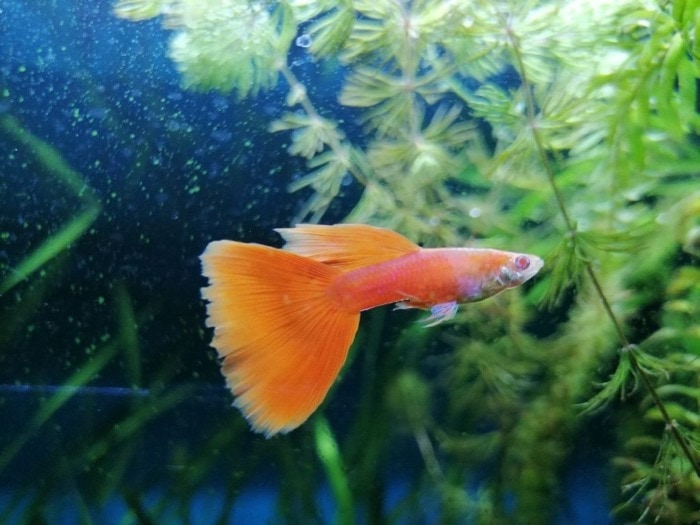
| Maximum Size: | varies with types but usually no more than 1.4 inches (3.6 cm) |
| Suggested Tank Size: | 5 gallons but larger tanks are better for groups and management of fry |
| Suggested Water Temperature: | 72 to 82°F (22 to 28°C) |
| Suggested pH range: | 6.8 to 7.8 |
The Orange Guppy is among the many breeds of the common guppy fish from the Poecilia genus. They are descendants of wild guppy populations native to the freshwater streams and rivers of South America, particularly in Brazil, Guyana, and Venezuela.
Orange guppies are known for their vivid color, ranging from pale peach to deep tangerine.
The average lifespan of guppies is 2 to 3 years.
This tiny orange fish is exceptionally hardy and can survive staggering temperature drops down to 55°F. Due to this, it is often cited as one of the best small pond fish.
However, to thrive, it should be kept in a temperature range of 72°F to 82°F.
Apart from its hardiness, the Orange guppy fish boasts a magnificent fantail that exudes an almost regal elegance during swimming.
If you’ve never kept guppies before, you should remember that they breed extremely fast.
So if you keep a group of them in a small 5-gallon tank, they will populate it quite fast unless you export the fry.
Like many other live-bearing fish species, Orange Guppies have a unique reproductive strategy known as ovoviviparity. This means that female guppies give birth to live, free-swimming fry instead of laying eggs.
After mating, female guppies undergo a gestation period of around 4 to 6 weeks, throughout which the embryos develop within their bodies. As the pregnancy progresses, the gravid spot located near the female’s vent darkens, indicating the presence of fry.
When the gestation period is complete (28 days ), female guppies give birth to fully formed fry. Depending on factors such as water temperature and diet, a single female guppy can produce anywhere from 20 to 100 fry in a single brood.
Through selective breeding, breeders have selectively propagated guppies with increased pigment production, resulting in vivid orange hues ranging from pale peach to deep tangerine.
Breeders often use techniques such as line breeding, outcrossing, and hybridization to introduce and enhance desirable traits while minimizing undesirable characteristics.
To control the population, some strategies must be taken into account:
Separate Breeding Tanks: Set up separate breeding tanks .
Frequent Monitoring: Monitor pregnant females closely and be ready to shift them to separate breeding tanks.
Population Control: Consider periodically culling excess fry to prevent overcrowding and maintain a manageable population size.
Tips for maintaining the optimal tank setup for orange guppies:
-Regular Water Changes: Perform weekly or bi-weekly water changes of around 20-30% to remove accumulated waste and replenish essential nutrients.
-Monitoring Parameters: Use reliable test kits to regularly monitor water parameters such as ammonia, pH, and temperature
-Avoid Overfeeding
-Maintain Good Aquarium Hygiene: Clean substrate, decorations, and filtration
-Quarantine New Additions
The Best Species for A Small 3.5-Gallon Fish Tank
If you intend to use a small gallon count fish tank, you need to ensure you’ve the right minute fish that can live comfortably in it.
However, I have taken the time to do your homework for you.
These are the best micro fish for a 3.5-gallon tank:
- Indonesian Superdwarf fish
- a single Dario Dario
- Dracula minnow
- Male Least killifish
- Dwarf rasboras
Top Fish Selections for a 5 To 5.5 Gallon Aquarium
If you have space for a micro aquarium of 5 gallons and above, you should go for it (link to Amazon, to check some good tank options). I have taken the time to gather and highlight the right sections for your convenience.
That being said, here are some of the best micro fish for a small 5-gallon tank:
- 15 Indonesian Superdwarf fish
- 3 Dario Dario
- 3 Gulf Coast Pygmy Sunfish
- between 6 and 10 Danionella Dracula
- 4 pygmy corydoras
- 10 Dwarf rasboras
- 12 Chili Rasboras
- 7 Least killifish
Something You Should Know About Looking After Nano Pet Fish
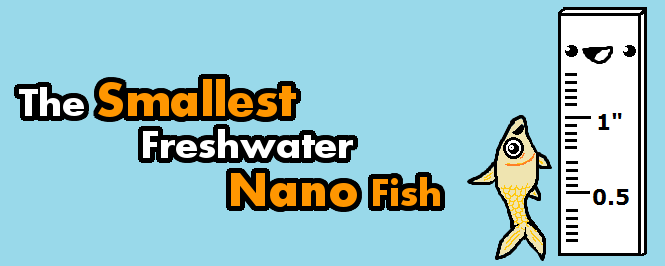
Small fish tanks may occupy less space, but they come with some serious inconveniences. For one, water is polluted too soon in such confined spaces.
The decomposing wastes raise ammonia or nitrites concentrations, which are both extremely toxic to live fish. There could also be a fluctuation in Ph (the water’s acidity), which again is extremely stressful and potentially lethal to aquarium inhabitants.
All of these volatile metrics may lead to an unhealthy tank environment for your new nano fish. You would have to change the water more often, and this too comes with its complications.
Visit the link to see an explanation of how accidentally changing too much water in a small tank can stress its fish residents.
On the other hand, a big fish tank is ideal.
Larger volumes of water are easier to maintain, and the aquarium’s water parameters remain stable once you have things set up.
Another thing to consider is that it’s well known that when fish feel confined in smaller aquariums they become more aggressive. Bear this in mind when you are deciding on your fish tank’s size.
I’m not saying it’s impossible to achieve. I’m saying that if you have the means – get the larger tank and all necessary side equipment. The ball is in your court.
My Final Thoughts
If you have any questions, feel free to post them in the comments section.
It was not an easy task to collect this information from all over the place.
It took me about 5 days of work to Aquanswer your concerns about relevant species for a thriving nano fish tank.
I did some heavy research in order to come up with the freshwater micro fish that are among the smallest ones in the aquarium hobby, even in their adult stage of life.
Mind that some of these will not be an easy find, but if you manage to get your hands on them – it’ll be absolutely worth it.



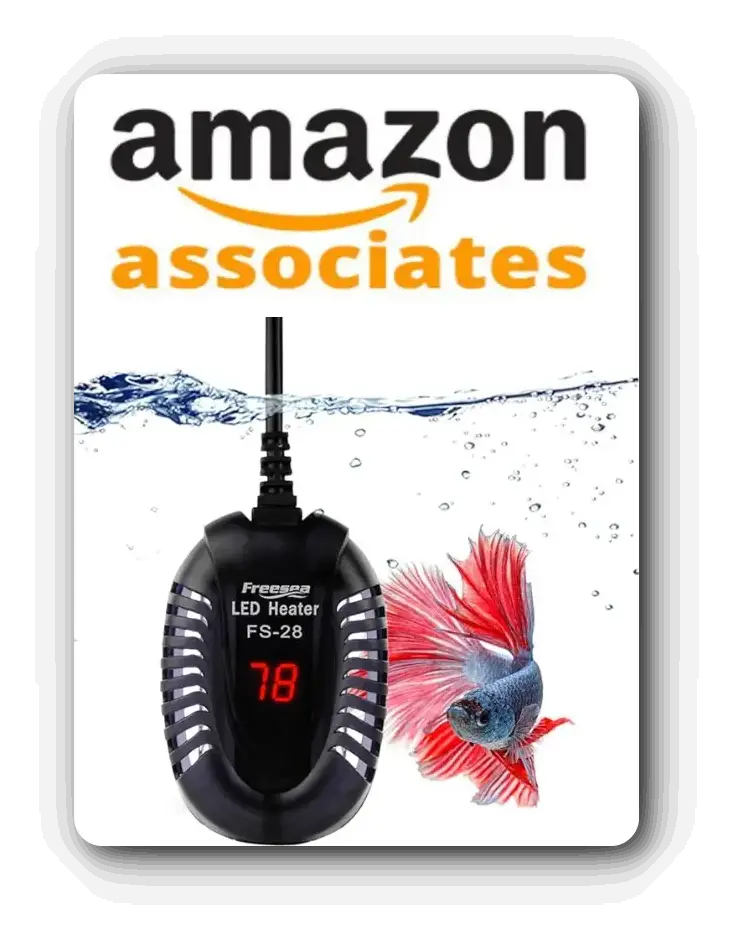

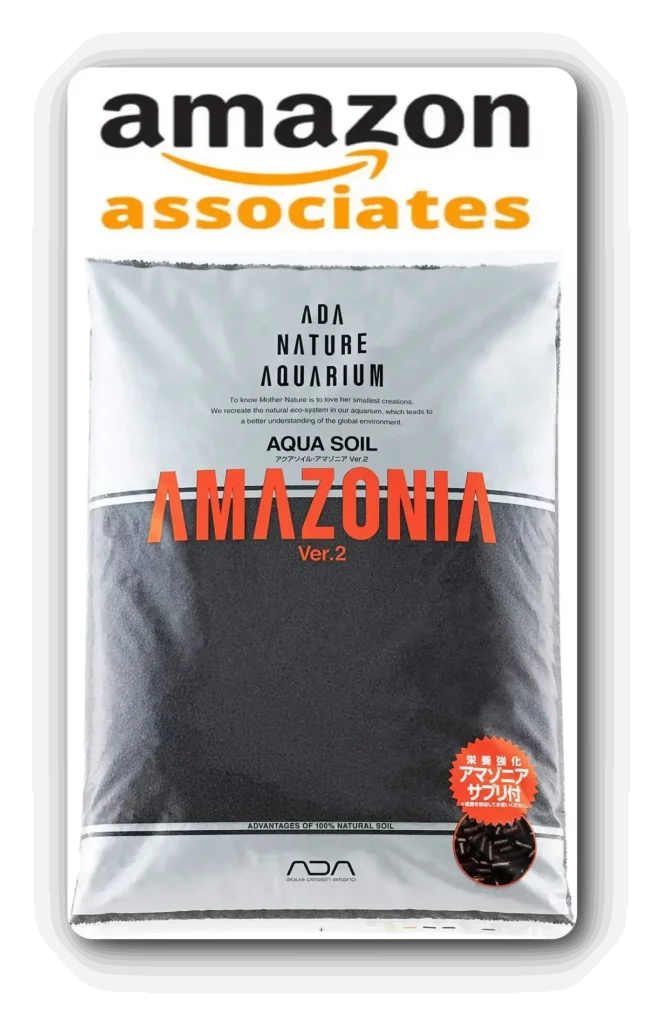


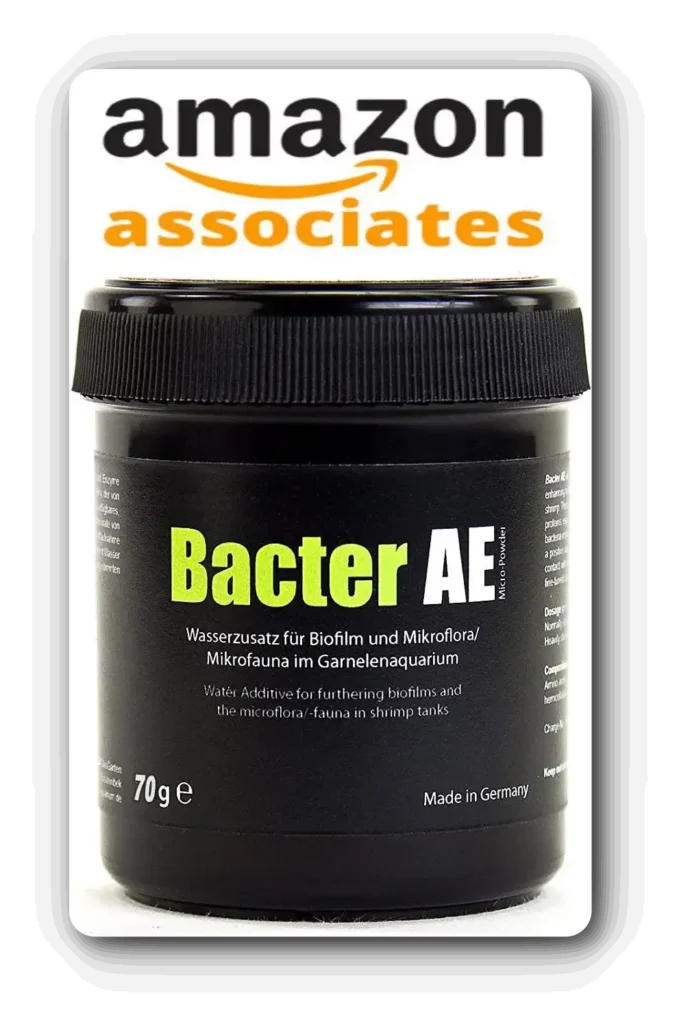
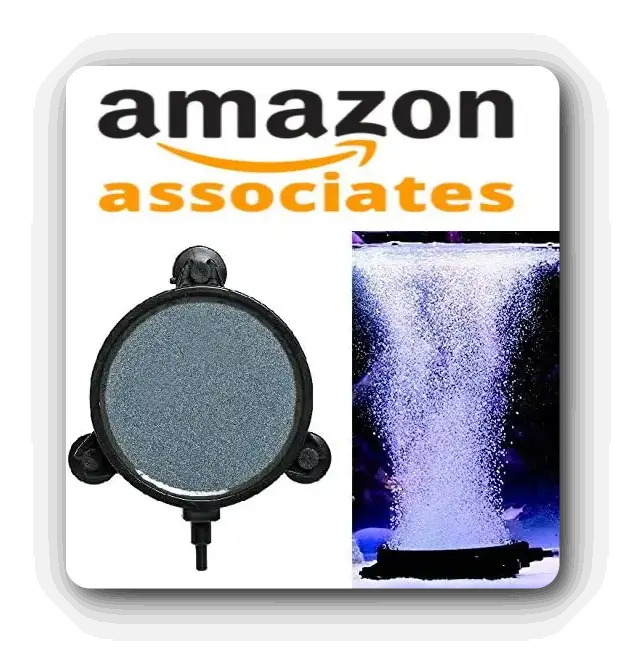


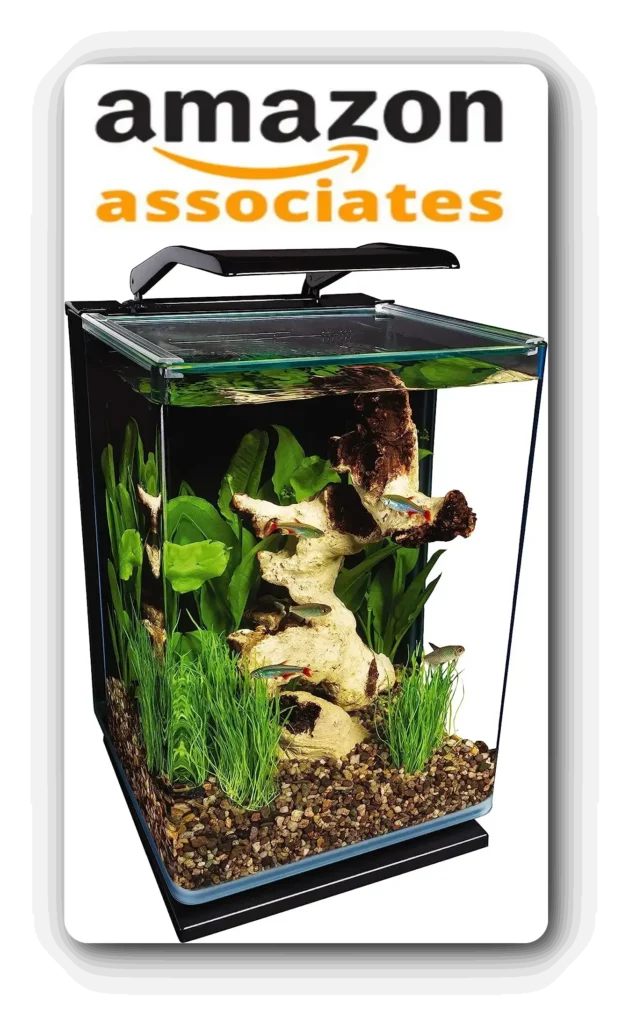

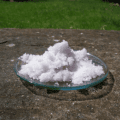
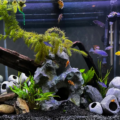




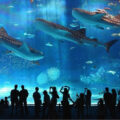
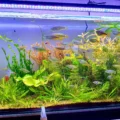
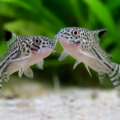
Hi. Looking for some advice on stocking. I have a 46litre fluval edge with one Betta and 6 Rummies. I’d like to add another tiny schooling fish i.e 8-10 chilli Rasboras or similar and maybe 1 Hillstream loach as well as 2 nerite snails and maybe 3 or 4 shrimp, would this be OK do you think? Thanks for any advice.
Hi, I’m getting a 10-gallon tank and I already have two of the bigger glow fish tetras, what other kinds of fish should I put in the tank, I’m not sure if this helps to know but I will have live plants in the tank, thanks!
Hi, Shea
The Glowfish Tetra fish, that you got, is a schooling type of fish, which means it needs to stay in larger groups of its own kind. Otherwise, these fish will show aggression and will nip the fins of each other and their tank mates. Unfortunately, Glofish tetras will not lead a happy life in a 10-gallon tank, so I suggest that you return them (for store credits if possible) and do more research on what to put inside. Glofish tetras need to be in a group of at least 6 and this means they’d need a 20-gallon tank at the minimum because they grow relatively large. From there on, most of the small fish listed in my article will do. You can also check this page for more ideas – https://aquanswers.com/best-fish-for-small-tank-5-gallon-freshwater/
Read on carefully and come up with a plan.
Regards,
Momchil
So I have a 29 gal breeder tank right now that is heavily planted with driftwood and dragon stone as well. Right now I have RCS, otocinclus, and Guppies but I would like to replace the guppies with more interesting fish. From this list my favorite is the galaxy Rasbora followed by gulf coast pygmy sunfish, white cloud minnow, least killifish and then ember tetra in that order. My predicament is that I don’t want my otos or RCS to be scared of any fish that I put in, currently even the shrimp babies don’t hide from the guppies and seem to be unscathed. Do you know which of these fish would leave the shrimp alone like the guppies do?
Hi and thanks for the question!
I’m basing my answer on my experience here.
Galaxy rasboras (celestial pearl danios) will make a mess out of the shrimp for sure.
I haven’t seen them do it, but I’d assume that Pygmy Sunfish would also eat shrimplets… However, they don’t bother adult shrimp.
White cloud mountain minnows will eat shrimplets.
Least killifish won’t bother adult shrimp, but I’ve seen them go after shrimplets. Really cool nano fish though.
Ember tetras will also eat baby shrimp, but are overall timid and mind their own business.
From the list, I can recommend the dwarf rasboras as baby shrimp-safe.
Also, you can try the threadfin rainbowfish! These guys hang out at the top of the water column. They may eat a shrimplet or 2, but that would happen rarely.
In general all of the aforementioned, except the Celestial Pearl Danios would not bother shrimps larger than their mouths (which is pretty much any shrimp that you can easily see).
Was this helpful?
Keep me posted.
P.S. – dragon stone with driftwood in a planted tank… My very favorite combo! Exquisite taste in aquascaping.
Thanks so much! I’ve been asking around everywhere for an answer to my situation and I finally feel I have gotten one that I can trust. I appreciate you replying so quickly and thoroughly. It’s taken me awhile to get my tank where I wanted to be and it finally is so thanks your the complement!
I have an all male endler group in a heavily planted 5 gallon tank. Every male is a completely different vivid colour. Watch them with a magnifying glass and they are like a rainbow. They are very happy, sociable non-schooling fish that aren’t aggressive to each other and very active. Always doing something interesting and tough little survivors. Rush to the front of the tank when they see you to beg for food so nice to interact with.
Hi, and thanks for sharing your valuable experience.
Endlers are a really cool small fish to keep at home! There are too many fish to be included in this list, so it’s nice when people comment with more options because I will not always be able to add them all.
Thanks, Clare!
Great compilation! Its my first time keeping fish and im going for a 5 gallon aquarium could you summarize as to which of the species that you have mentioned are the most hardy and forgiving?
Hi,
The White Cloud Mountain Minnows are hardy and prefer unheated water, but do appreciate a “longer” aquarium.
Pygmy Corydoras are a good choice. Dwarf rasboras are also hardy and active. The least killifish are very adaptive as well, but you may have a hard time finding them in your local store.
Hope this helps! 🙂
Hey, I am am about to start cycling a 5 gallon planted that I have been dry starting for about a month. Only rocks and small leaf plants. I was hoping to get some scarlet badis for the tank but I am worried they wont be happy with the small amount of coverage as I have no drift wood or large plants. I was planning on adding some shrimp after 2 weeks and after another 2 weeks the fish. Could I get some insight.
What about sparkling gouramis? They have the sweetest temperament ever and are really fascinating to watch! I think their max size is around 1″.
Hi there,
You are very much correct! I would never hesitate to look after sparkling gouramis. They reach around an inch and a half when mature, and a 10-gallon tank would be a good home for four or five specimens.
Thank you for your input
Hi, Thanks for the great info. I am just cycling a 5 gallon Spec V and am getting a betta and would like a couple of small tank mates for him. My water PH is 7.4. I read your article and especially like the Dario and Dwarf rasbora but the water parameters or the needs for more than 2 makes them not a great fit. Can you tell me what you might suggest? I like the super right colors of course the most. Thanks in advance for your time!. Margo
I’m thinking of getting a 4 gallon tank. Could I keep 2 male least killifish in it with a mystery snail? Can least killifish be kept in pairs or do they need a bigger school?
Hi Olivia,
Thanks for the question. Generally, livebearers will do well if you keep more females than males. 4 gallons would be okay for 2 in terms of space, however, the least killifish prefer schools with predominantly females. Following these thoughts, I am unsure of how well 2 male least killifish will work.
Let me know what you ended up doing.
Great information many thanks
Glad you enjoyed it.